Island Peak, locally known as Imja Tse, offers a tough challenge and incredible views of the Himalayas. At 6,189m, it is a tough test for many mountaineers and trekkers at such high altitudes. The peak is found in the Chukkung Valley and despite its height, the peak seems quite small when surrounded by the huge peaks of the Himalayas like Lhotse, Baruntse, and Nuptse. 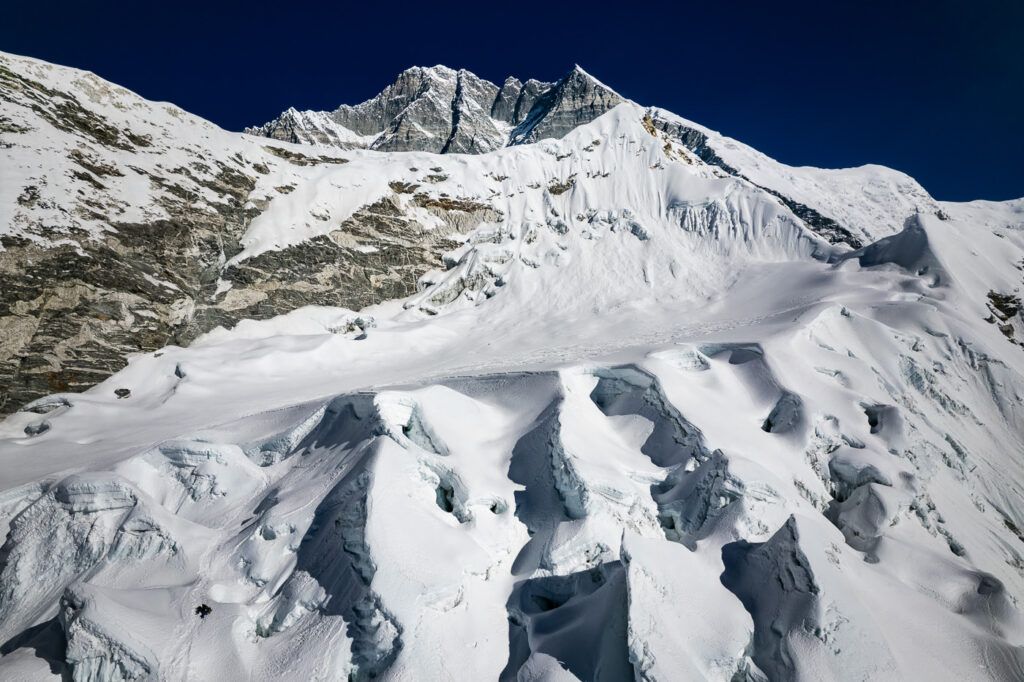
This spectacular 6000m peak was actually used as a training peak by Edmund Hillary and Sherpa Tenzing Norgay in 1953. The route they discovered is the same one that is used today and Island Peak is still a popular training peak for mountaineers attempting to climb Mount Everest.
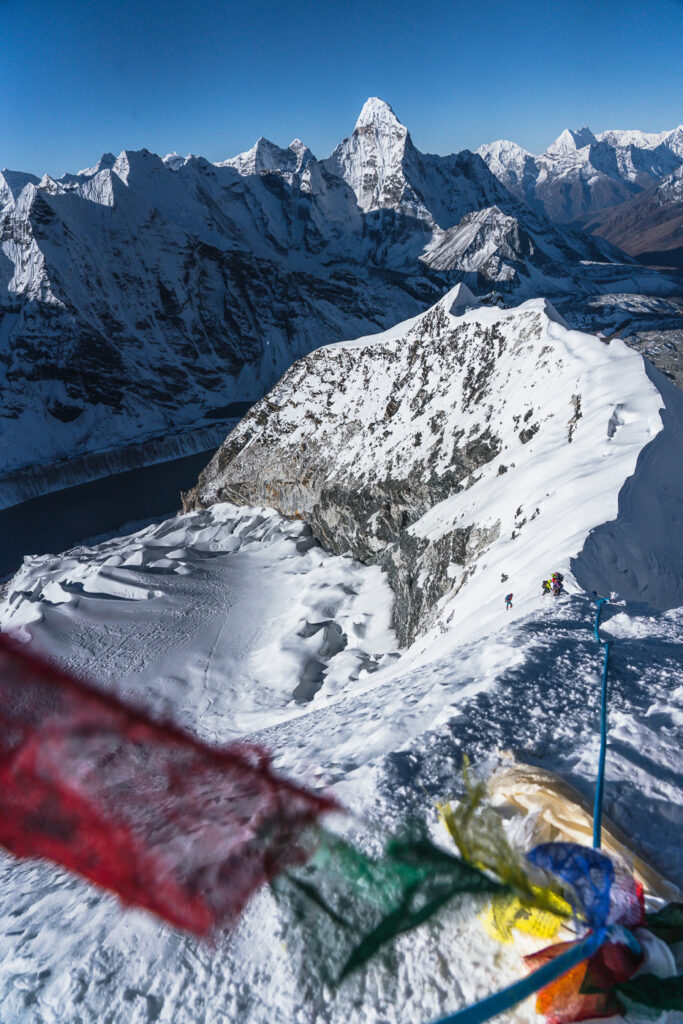
In this blog post, I will cover everything you need to know about the logistics of climbing Island Peak and also share with you my stories and photos from the climb. This will give you an idea of what to expect and a great insight into the scenery you will find en route to the summit. Before sharing my experience of the climb in the second section of this blog post, I will detail all of the information you need to know in this complete guide about climbing Island Peak.
BEST NEPAL TREKKING COMPANY
Interested in trekking in Nepal or doing the Everest Base Camp Trek?
I recommend booking your trek with Himalayan Masters, which is the company I use for all of my treks in Nepal. Use my code JACKSON5 when you book to receive a 5% DISCOUNT.
ISLAND PEAK MOUNTAIN DETAILS
- Days required: It takes only one day to climb but you need to add on 10-15 days in total for the trek in and out. It takes about a week of trekking to reach the Island Peak Base Camp from Lukla after flying in from Kathmandu.
- Height of Island Peak Summit: 6,189m
- Cost: $1500-$4000 depending on package inclusions but a regular, all-inclusive price starting and finishing in Kathmandu can be $2000 to $4000 depending on the company.
- Season to climb Island Peak: The most optimal time to climb Island Peak are during the spring (March to early June) and autumn (September to November).
- Difficulty of Island Peak: Island Peak is advertised as a trekking peak or beginner peak but it’s a pretty intense climb if it is your first foray into mountaineering or high-altitude mountains. From the base camp, you have 1000m of elevation gain to climb during the night. The final wall to the summit requires jumar technique and some good fitness as the climb can be very steep in parts. For an experienced mountaineer, Island Peak offers few moments of drama or intense challenges. For trekkers and beginners, this climb can be likened to a summit push on Kilimanjaro. The jumar technique can be learned at base camp and is relativley simple. You don’t need any prior skills just some good trekking and mountain experience as well as a decent base-level of fitness.
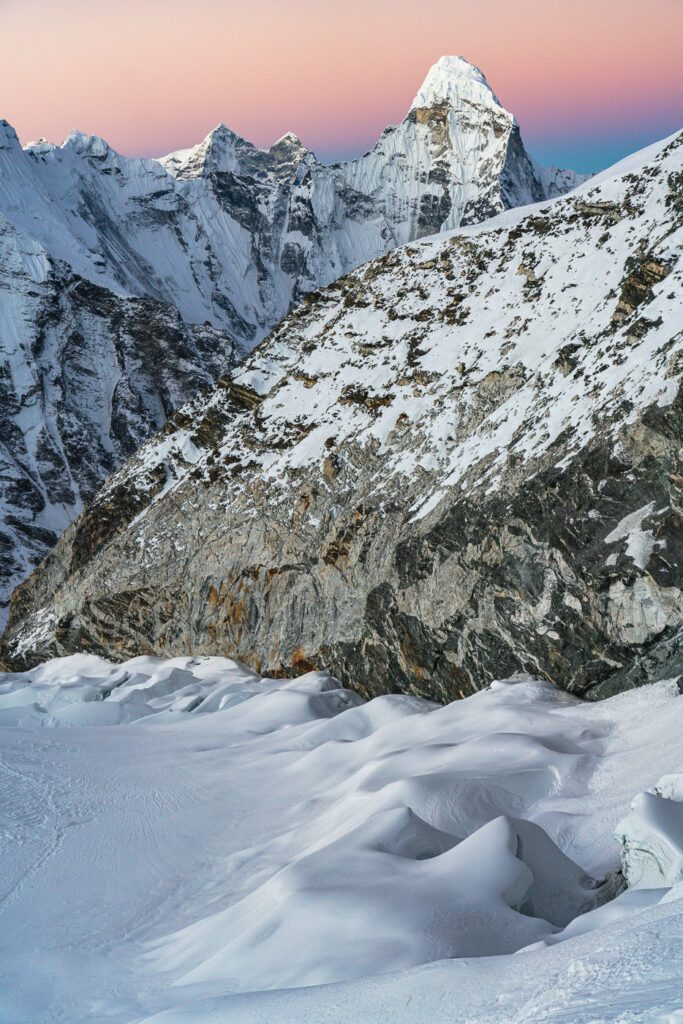
TRY THE 3 BEST TREKS IN NEPAL
Manaslu Circuit: My personal favorite 2-week trek through Tibetan villages and stunning scenery with less crowds.
Annapurna Circuit: The most beautiful & scenic 2-week trek in Nepal although can be crowded at times.
Everest Base Camp Trek: The most iconic 2-week route reaching the famous (EBC) Everest Base Camp at 5,300m.
GETTING TO AND FROM ISLAND PEAK BASECAMP
There are several different options for how to arrive and depart from Island Peak Base Camp (4,600m).
- Helicopter: These days, many mountaineers can afford to fly into Namche or nearby towns along the trekking route. The flight runs directly from Kathmandu or you can fly by plane to Lukla and then helicopter from Lukla. The flight from Kathmandu to Everest Base Camp is $3000 USD as of 2021. Most tour operators will organize this helicopter option as part of the package if you choose it as an add-on.
- Trekking in from Lukla: One of the most scenic ways to reach base camp is to trek along the Everest Base Camp route after flying by plane to Lukla. It takes 5-7 days, depending on your pace, to reach Island Peak Base Camp by trekking in. Along the way you will stay at beautiful tea houses, pass by historic Tibetan monasteries and most importantly, slowly acclimatize your body to the altitude. This is a much safer option for your body’s adaptation to altitude rather than flying in directly by helicopter, which gives your body no time to adjust. I trekked in and loved staying in the historic Namche Bazaar and Phortse, which is the town with the most Everest Summiteers. It is common to combine a Everest Base Camp trek or a Mera Peak climb with a climb of Island Peak.

TOP 3 PLACES TO STAY IN KATHMANDU

- Ultimate Luxury: The Dwarika’s Hotel – Luxury, Spa-service, Pool
- Best Value: Aloft Kathmandu Thamel – Swimming Pool, Gym & Great Restuarant
- Budget Choice: Hotel Jampa is easily the top cheap hotel in Kathmandu
IS ISLAND PEAK DANGEROUS?
Island Peak is a relatively safe climb with a very low death rate. The main dangers are in the crevassed area of the route.
However, with good guiding, you should be roped up here, and usually, the route is very safe and defined through this area. Once you reach the areas of exposure on the ridge and at the final wall to the summit, you should be clipped into the rope at all times. Therefore, many of the incidents over the years have been due to negligence rather than the danger of the climb.
Overall, it is categorized as safe without imminent risk of avalanche, rockfall, icefall, or major exposure without fixed lines.

WHICH COMPANY I CLIMBED WITH FOR ISLAND PEAK
I climbed Island Peak with Seven Summit Treks who are the top Nepali climbing company in the country. They offer expeditions to all of the 8000m peaks and many other climbs, treks, and logistical services. This was my fourth expedition in Nepal and Pakistan and definitely the best and most well-organized. Seven Summit Treks were very detailed and had everything sorted.
The main thing I loved about Seven Summit Treks was the variety of climbers joining the company on their different expeditions. Throughout the expedition here on Island Peak and Ama Dablam, we shared the mess hall with professional alpinists and beginners looking to climb their first peak.
Everyone mixed together and had space when they needed private time. It was a very relaxed atmosphere with no ego, drama, or politics amongst decision-making that I had seen and experienced among other companies on the mountain. It was overall a great experience and I’d love to do more expeditions with Seven Summit Treks.
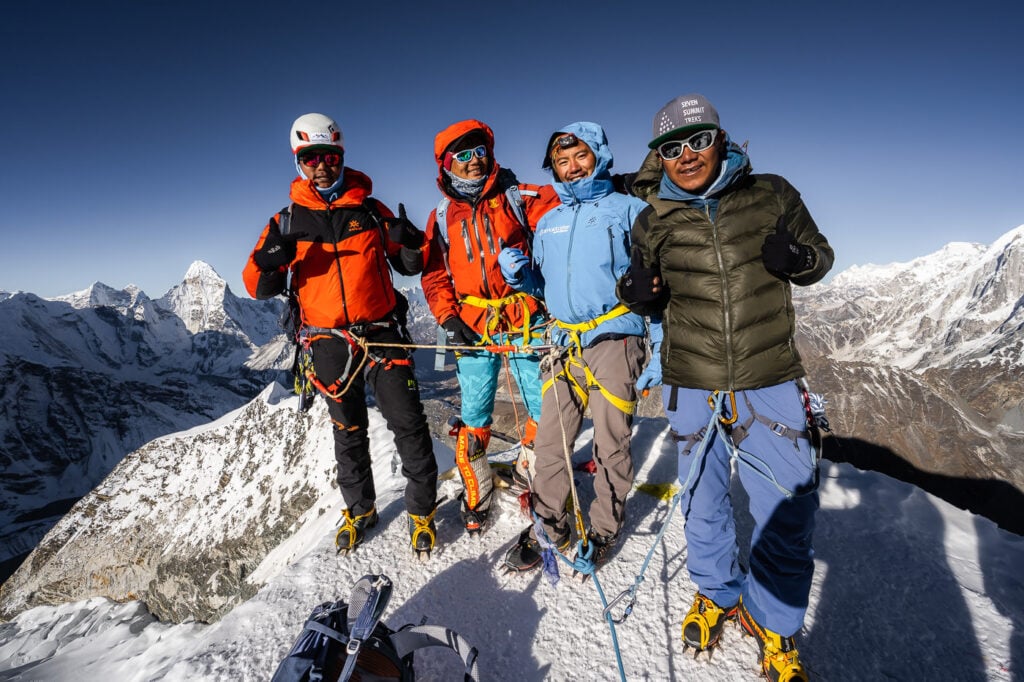
ISLAND PEAK BASE CAMP
Island Peak Base Camp is a permanent fixture throughout the two seasons for climbing this peak. Situated at 5,087m, it is a great base to launch from for the summit push. While there are some people who prefer to use the high camp, there are almost no facilities there so most climbers are making one big summit push from the base camp itself.
Basically, the situation for Island Peak is that at the base camp, you have very simple facilities such as a tent with a foam mattress inside. There is a small dining room tent where you will be provided meals by the base camp wardens.
Breakfast, lunch, and dinner are available. You can expect meals like noodles, Dal Bhat, Sherpa stew, and other hearty but easy-to-prepare recipes. The team will also boil water for drinking.
There is a basic toilet set-up and that is about it. Unlike a bigger basecamp for large expeditions, there are no frills here. Because most guests just stay one night or a maximum of two nights, the Island Peak Base Camp is set up to provide climbers with the basic necessities they need for their summit push.
Overall, it was a comfortable stay and the foam mattress was a nice surprise. The meals were basic but quite tasty and we appreciated the team cooking us eggs and toast at 12:30 am in the morning before our summit push!
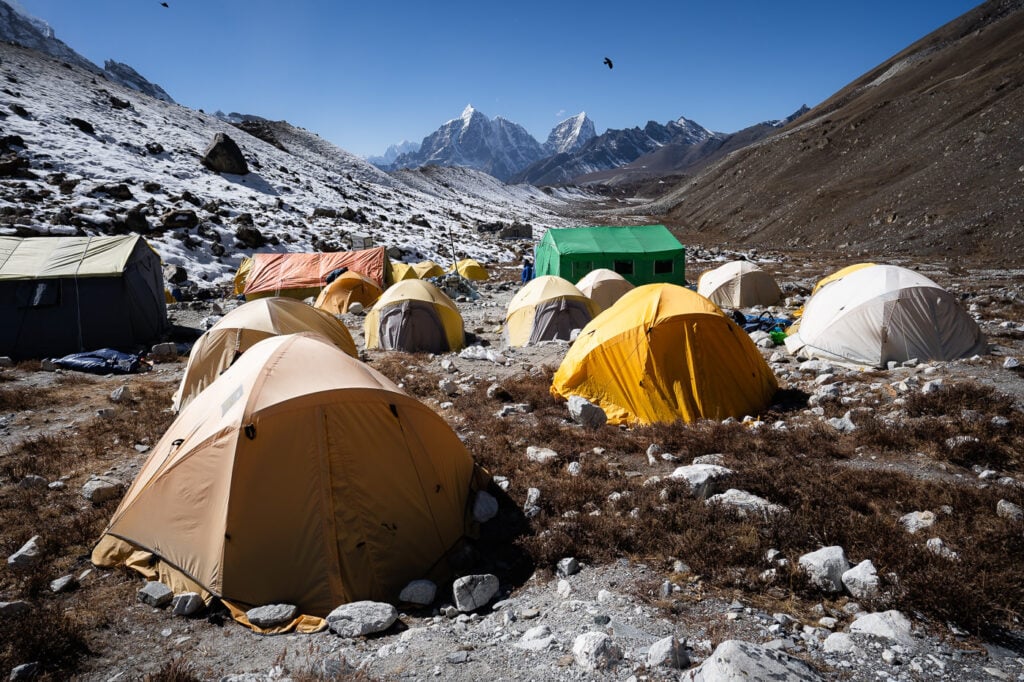
MY EXPERIENCE CLIMBING ISLAND PEAK
Climbing Island Peak is normally a stand-alone expedition or it can be combined with Mera Peak or the Everest Base Camp Trek. However, sometimes it is even used as an acclimatization climb for a more challenging peak such as Ama Dablam or Mount Everest.
I’ve always wanted to climb Island Peak as one of my first high-altitude experiences. This year I unexpectedly started climbing and summited Spantik and Manaslu in consecutive months. I then landed myself on an Ama Dablam expedition, which is just around the corner from Island Peak.
After our first rotation to Camp Two on Ama Dablam, there was a high volume of climbers trying to summit on a specific date. With the idea to try and avoid the traffic jam on Ama Dablam, we made the move to trek down to Island Peak Base Camp and planned o make a summit bid for Island Peak. We would then return to Ama Dablam to finish our climb there. Everything worked out according to plan.
Although my itinerary for Island Peak is not the regular trekking and climbing schedule, I still trekked the exact same route as Island Peak summiteers and shared the same base camp and conditions. Therefore I will share with you all of the details of what you can expect with the regular trekking route and climb of Island Peak (rather than as a detour from Ama Dablam).
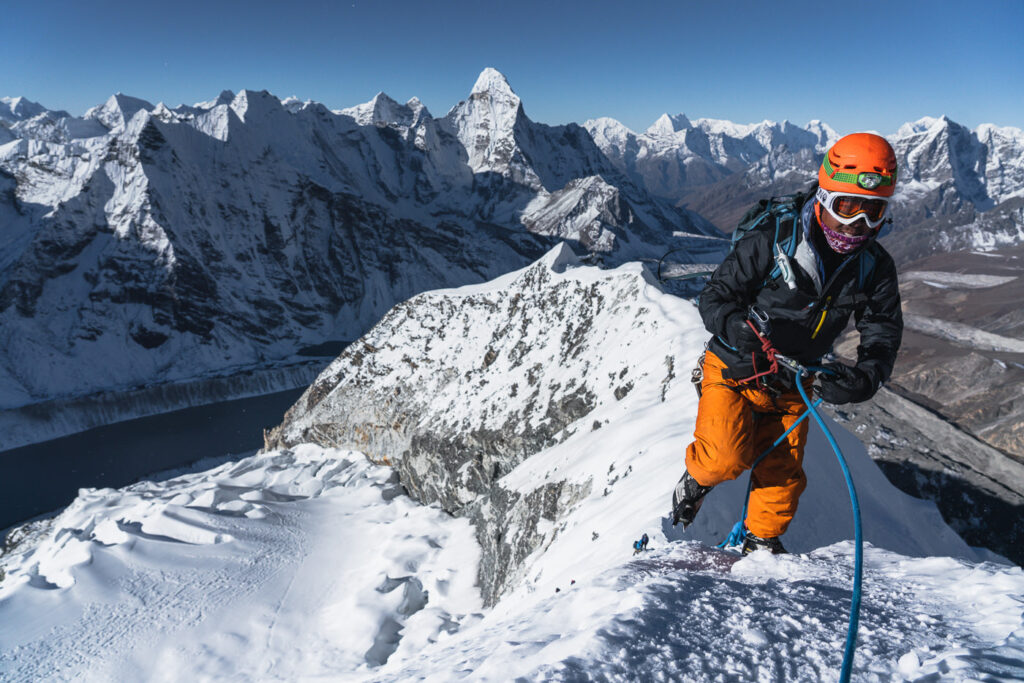
TREKKING TO ISLAND PEAK BASECAMP
Our Journey began at Kathmandu airport where we boarded a flight on a rickety old plane taking off in the direction of the infamous Lukla Airport. Flying out of the busy and colorful Kathmandu was the last time we would see city civilization for a month, as we headed deep into the Khumbu. The plane flight isn’t for the faint-hearted. The pilot cruised perilously close to the mountains before landing on the upward sloped and dramatically short runway into Lukla, the port to the Himalayas.
It was a reminiscent landing for me, having trekked to Everest Base Camp four years earlier. Not much has changed in Lukla. Despite the huge influx of trekkers and tourists over the years, Lukla has kept its mountain charm. Our trek would not be quite as long as that of Everest Base Camp.
The journey to Island Peak Base Camp is quite a pleasant hike over 6-7days with one ‘rest’ day or acclimatization period. There are a couple of different route options but our itinerary was as follows.
- DAY 1: Lukla to Phakding (7km)
- DAY 2: Phakding to Namche Bazaar (10km)
- DAY 3: Rest day
- DAY 4: Namche Bazaar to Phortse (12km)
- DAY 5: Phortse to Dingboche (11km)
- DAY 6: Dingboche to Island Peak Base Camp (11km)
- After landing in Lukla, we had a short, 7-kilometer walk to the small riverside town of Phakding. This first day of walking is actually mostly downhill despite some undulation with a net loss of a few hundred meters. The shady route winds through the forest while maintaining close proximity to the river rapids below. With just a couple of hours’ worth of walking, you will find your rhythm and learn how to avoid the donkey and yak caravans, which cart supplies up and down the mountain. Phakding has a number of cute teahouses and coffee shops to help you settle in for your first night in the Himalayas.
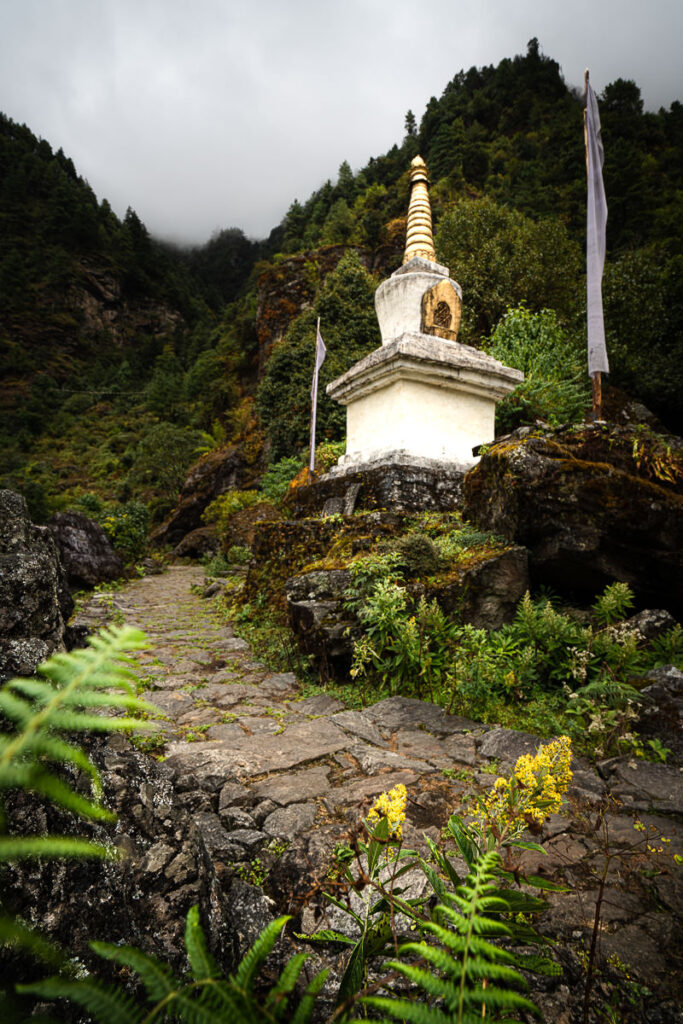
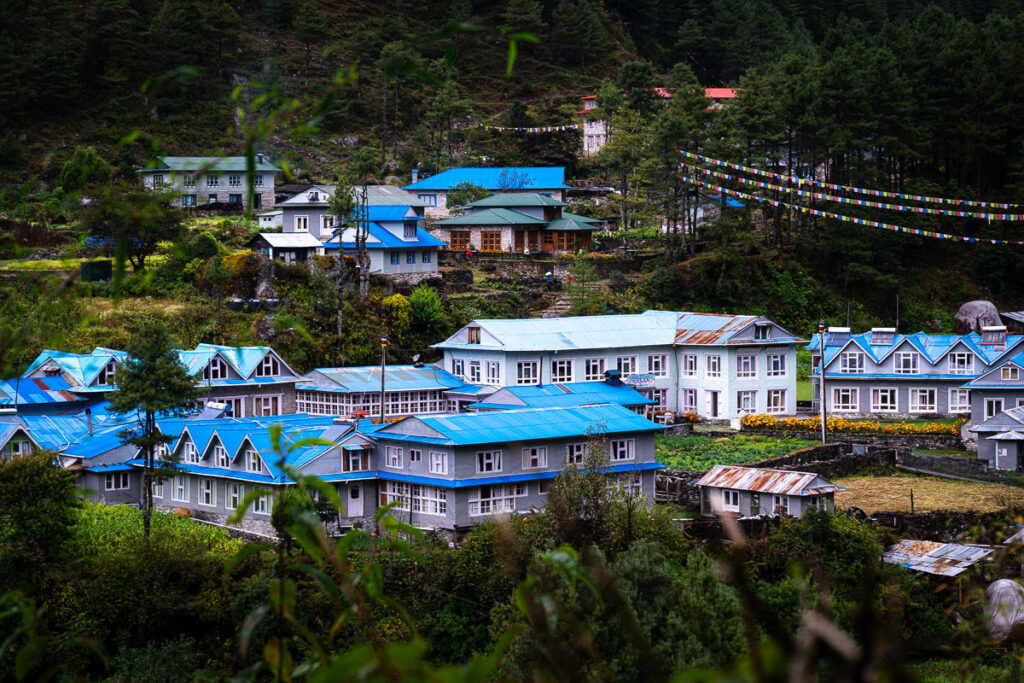
The second day of our trek to Island Peak Base Camp saw us heading towards the famous trading town of Namche Bazaar. The route crosses the river several times today, often on long suspension bridges draped in Tibetan prayer flags. After crossing the Hillary Bridge, there is some significant climbing to be done before reaching Namche Bazaar.
The total incline for the day surpassed a vertical kilometer with more than 1000 meters climbed. Namche is one of my favorite towns with a rich history of climbing, Sherpa culture, and trekking. In Namche, you can find just about everything from trekking stores to cafes and even an Irish Bar. It’s one of the last times you will have a lot of ‘city luxuries’ available and a good chance to add anything to your pack you may have forgotten for the climb.
We had a couple of nights here to help acclimatize and spent them at the Irish Bar for beers at night and the Sherpa Barista Cafe for coffee during the day.
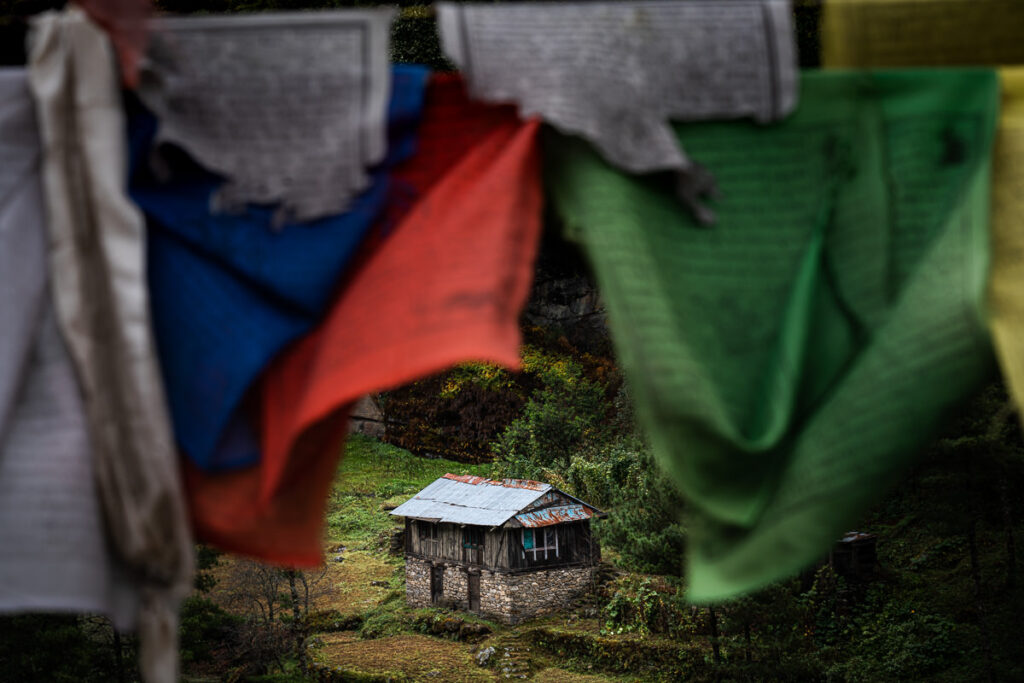
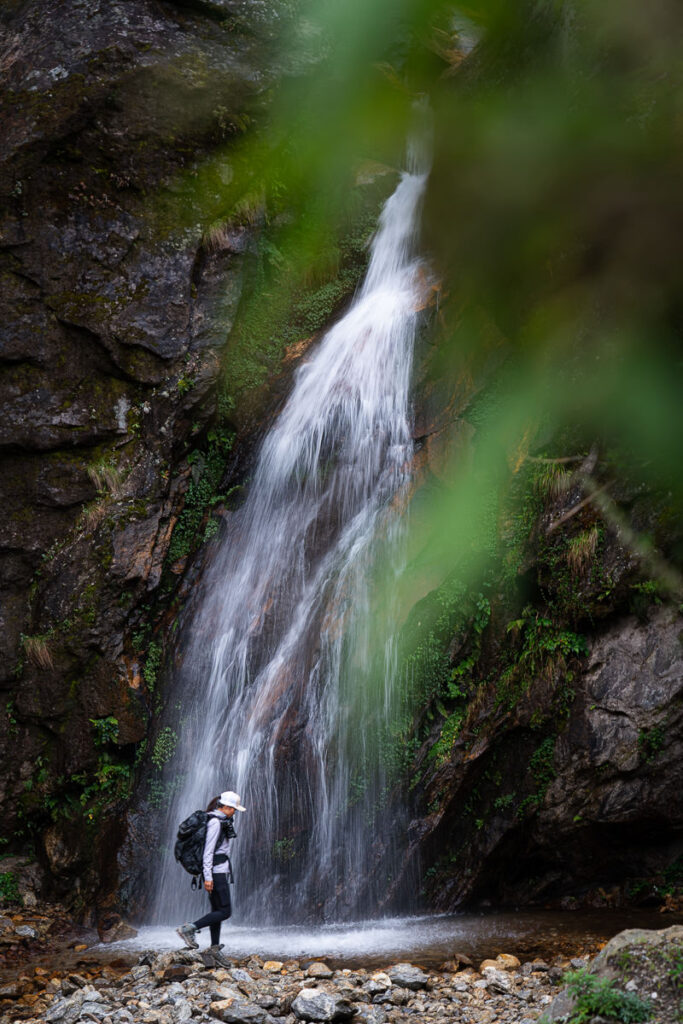
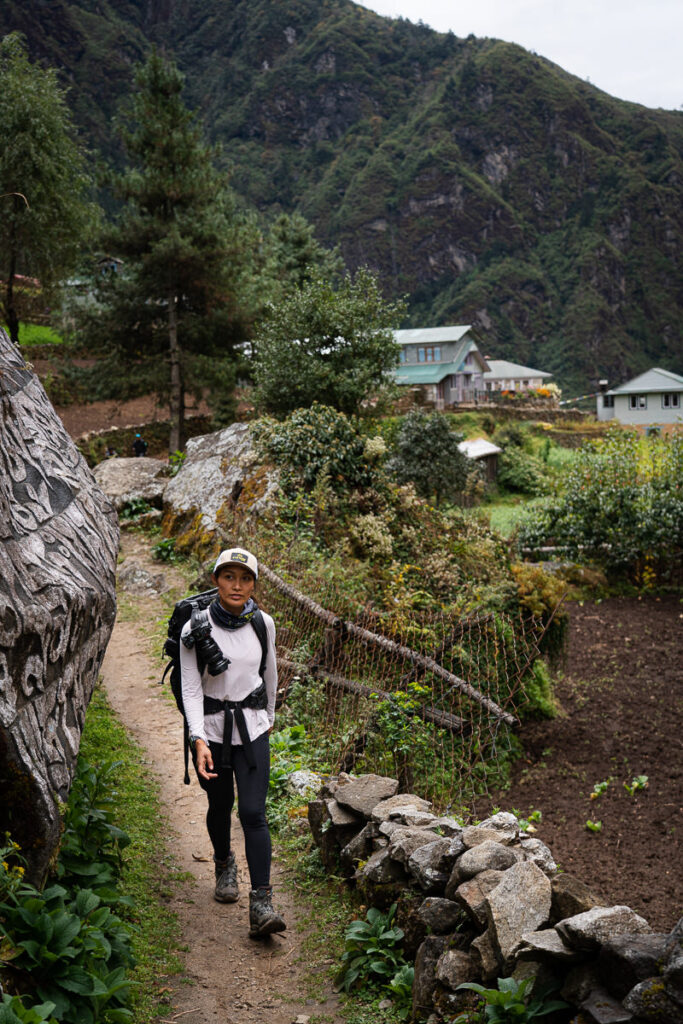
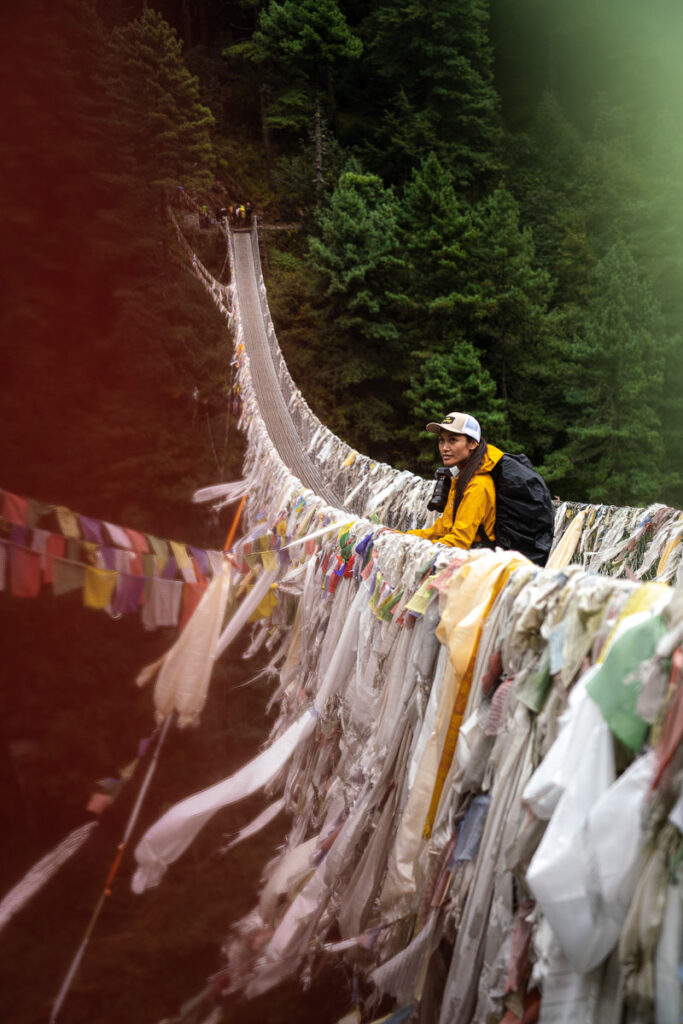
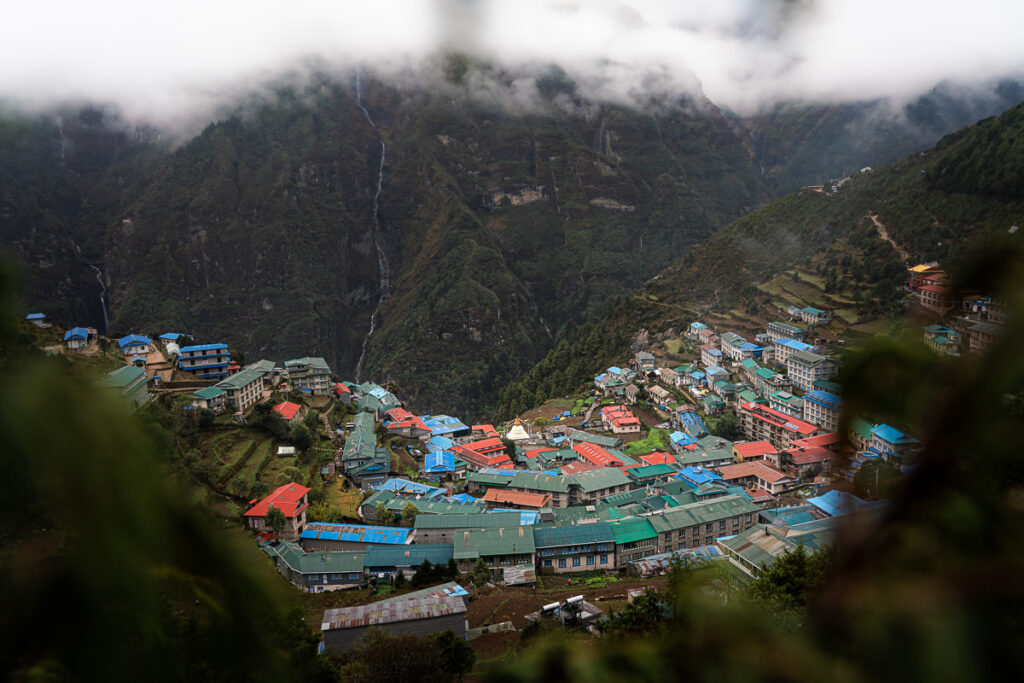
From Namche Bazaar, we trekked on to the village of Phortse. While it may be a small and seemingly innocuous village, there is something in the water of Phortse. This village has the most Everest summiteers per household of anywhere in the world. We had now settled into a trekking rhythm and were enjoying the coziness of the tea lodges along the way.
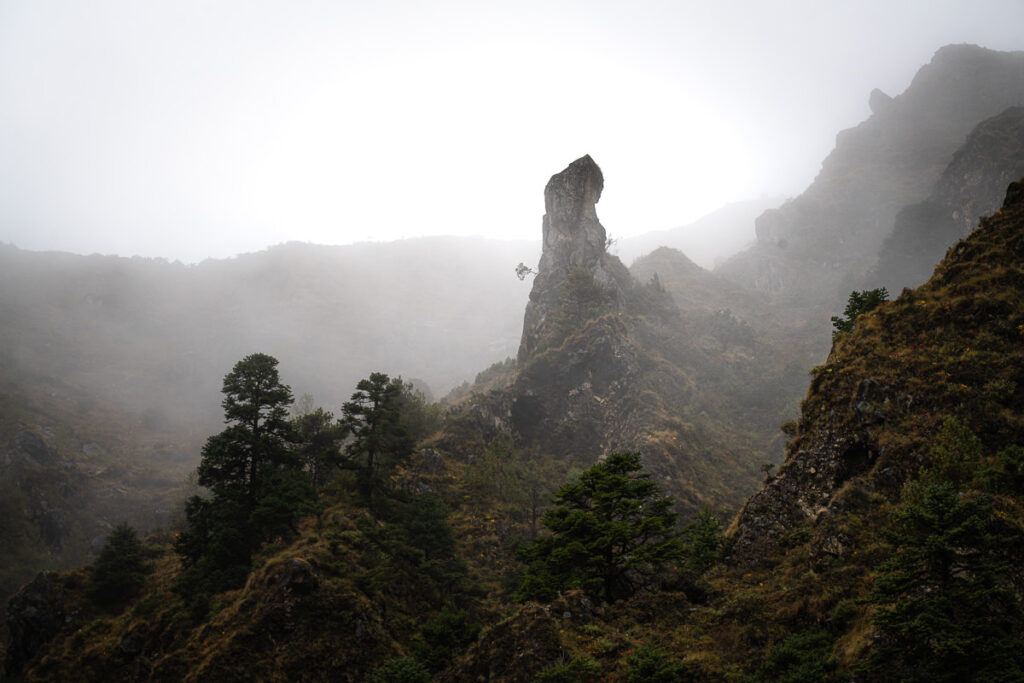
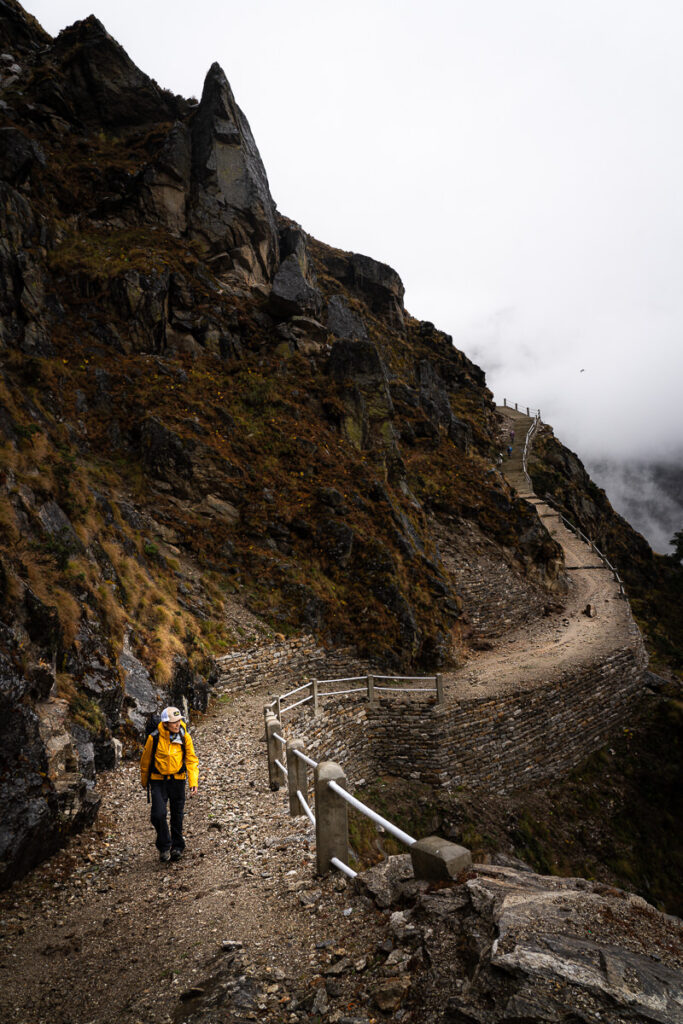
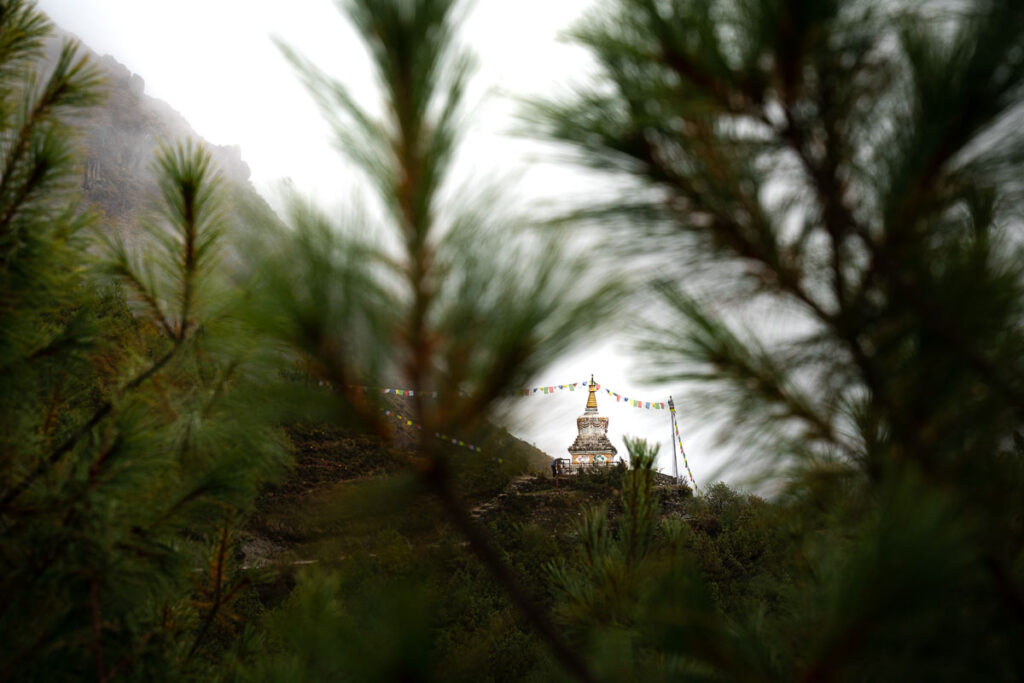
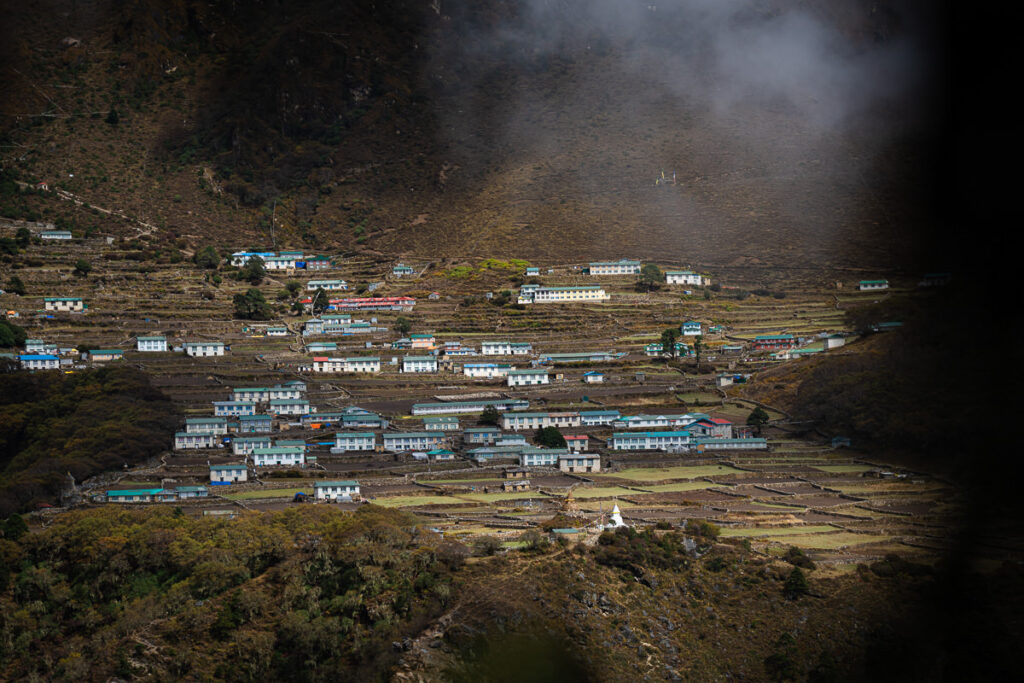
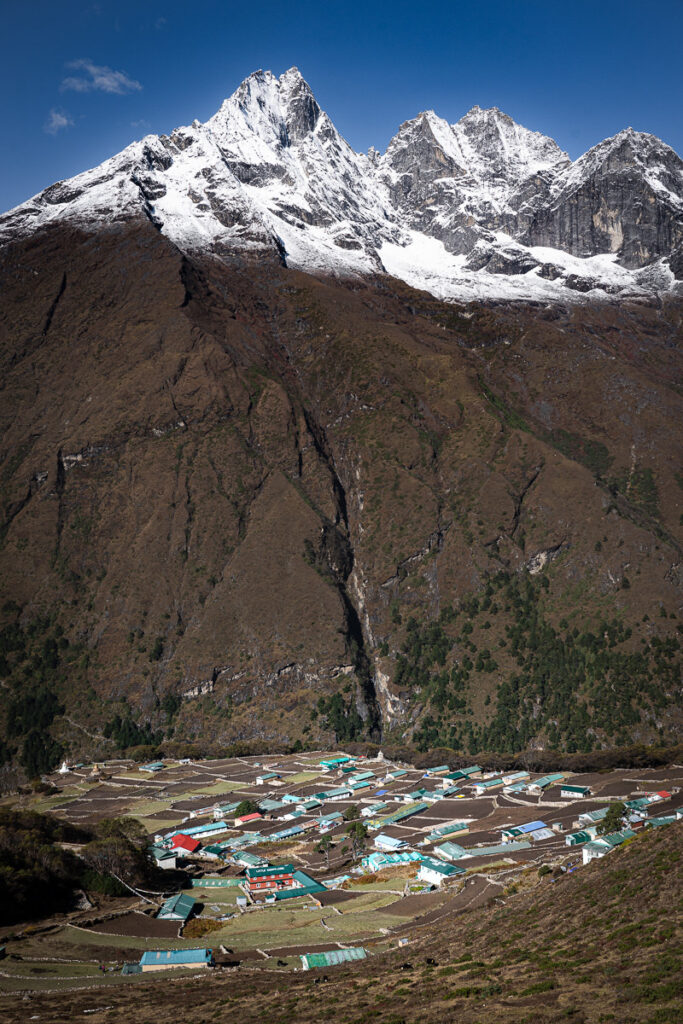
Our fifth day of trekking was arguably the most exciting. As the trail winds along the cliffside from Phortse to Pangboche, the view of Ama Dablam was just stunning. Reaching Dingboche was incredible with views of Ama Dablam directly out the window of the tea lodge. There was just a short walk the next day to reach our destination, Island Peak Base Camp.
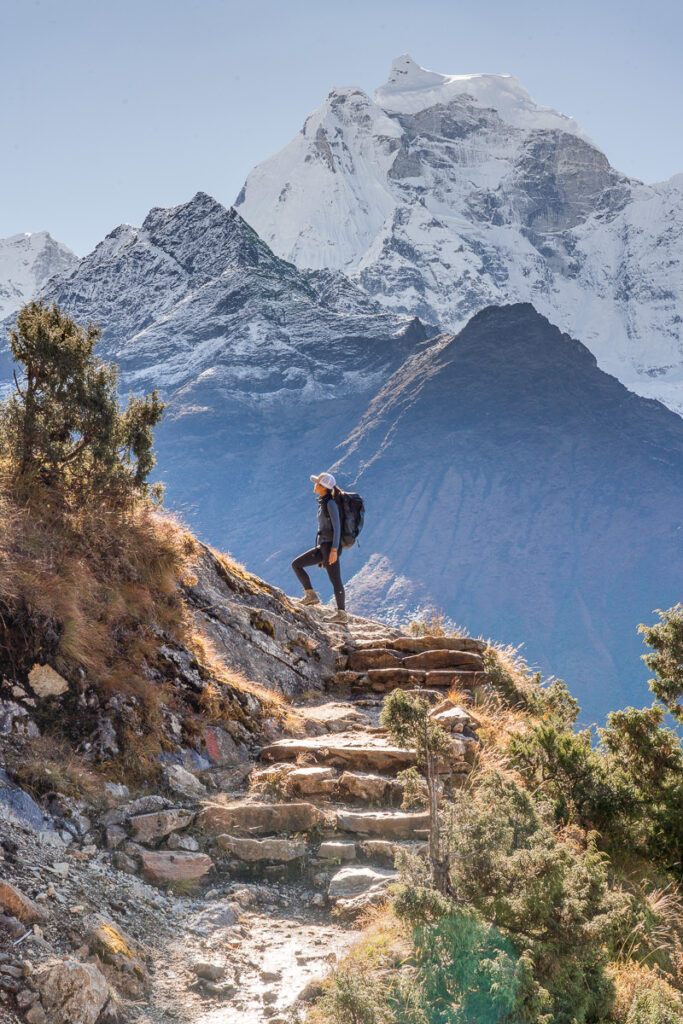
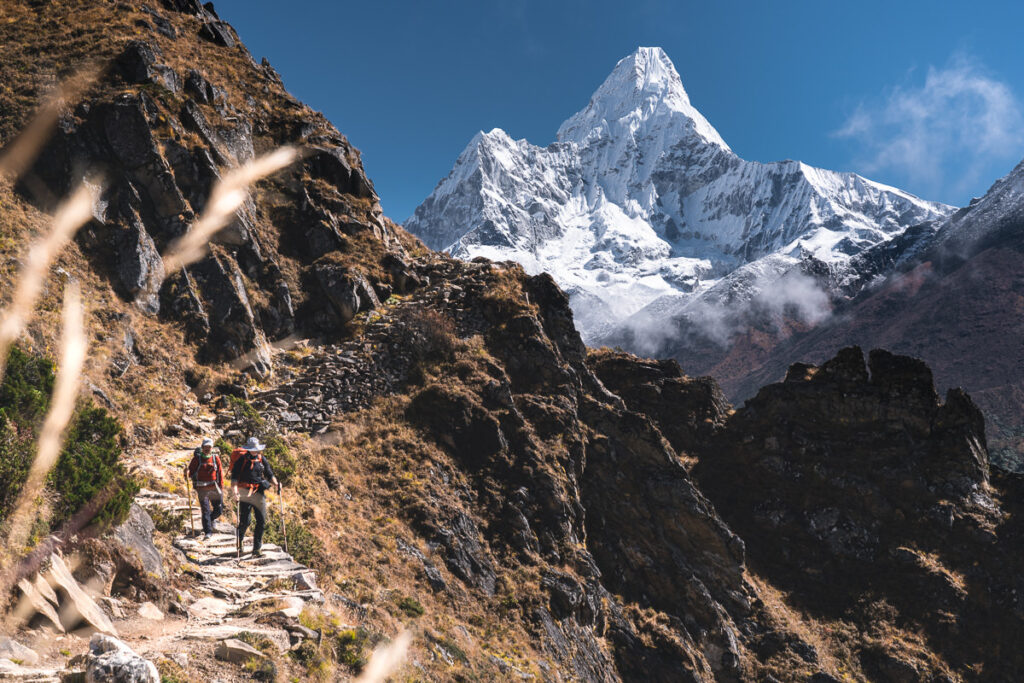
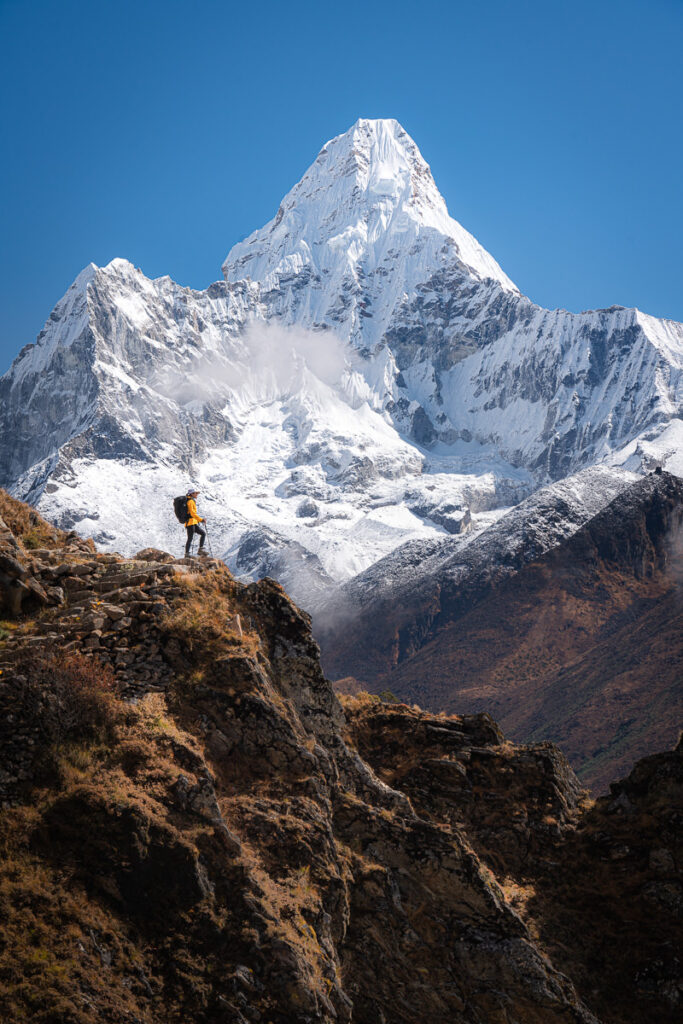

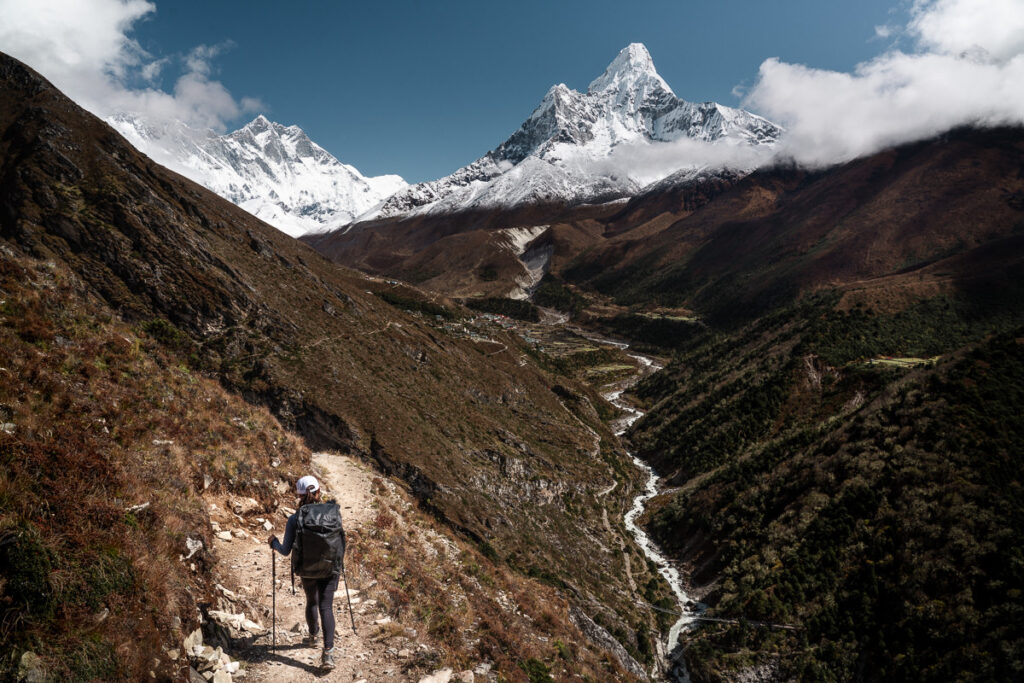
From Dingboche, the trail winds up and over the river with a solid elevation gain of 700m throughout the day. A quick tea stop in Chukhung made a good halfway break before we arrived at Island Peak Base Camp and got settled in and organized all of our gear.

CLIMBING ISLAND PEAK
Our plan for climbing Island Peak was to launch off from base camp and summit at sunrise before coming back down to base camp that morning. It’s a pretty standard approach and seemed to be the main way the peak is climbed. You can use the ‘high camp’ area but there’s no infrastructure, no water and it seems a hassle and unnecessary. This is why the guides try and promote the base camp to summit approach.
We got a few hours of sleep in our tent before the summit push, which helped to give us some energy for the climb. Waking up at 12:30 is never easy but we were lucky enough to be provided with coffee, eggs, and toast by the dedicated base camp team.
The climb begins by trekking in the darkness up the winding, rocky path. This part of the climb is slow and grueling but all about managing your energy and surviving the cold. For the first 500m of incline, there are no major obstacles other than some small traverse sections with some exposure.
Note: Many of the photos in this blog were taken by a drone, for which you need a permit in the Khumbu region. I did indeed have a permit to fly. Also, I took many of the photos on the way down from the summit as it was dark on the way up in case you are wondering why the early parts of the climb include photos in daylight.
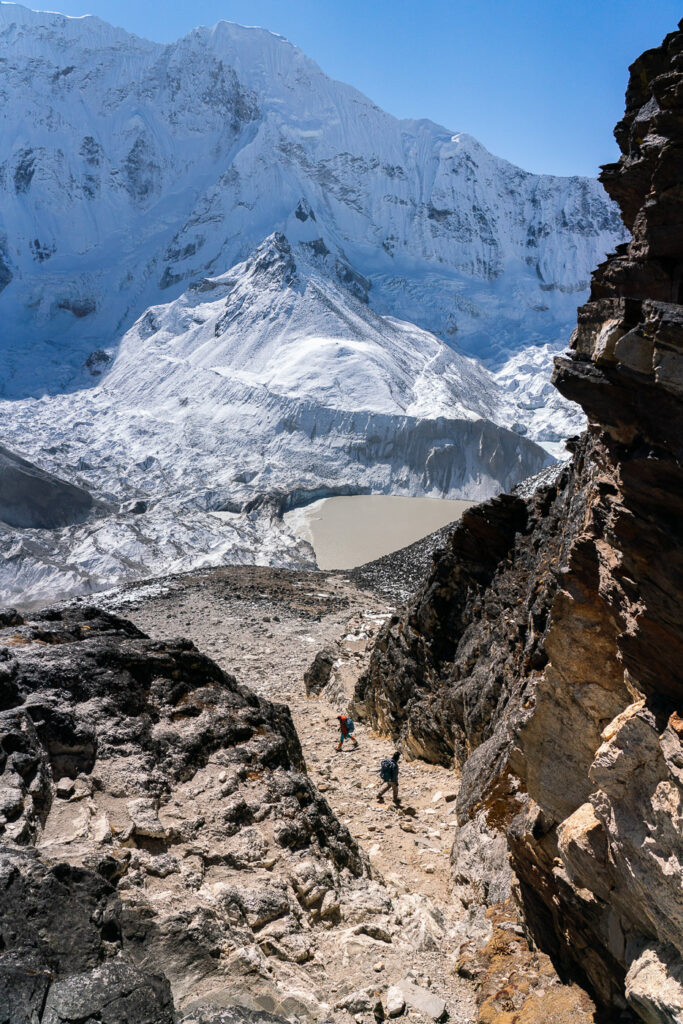
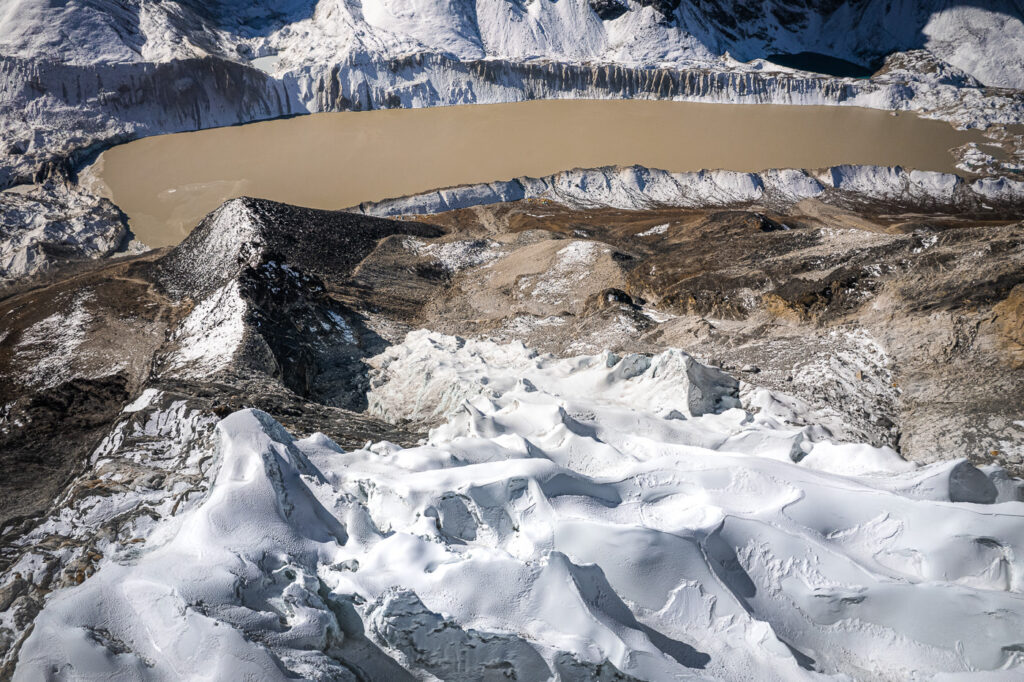
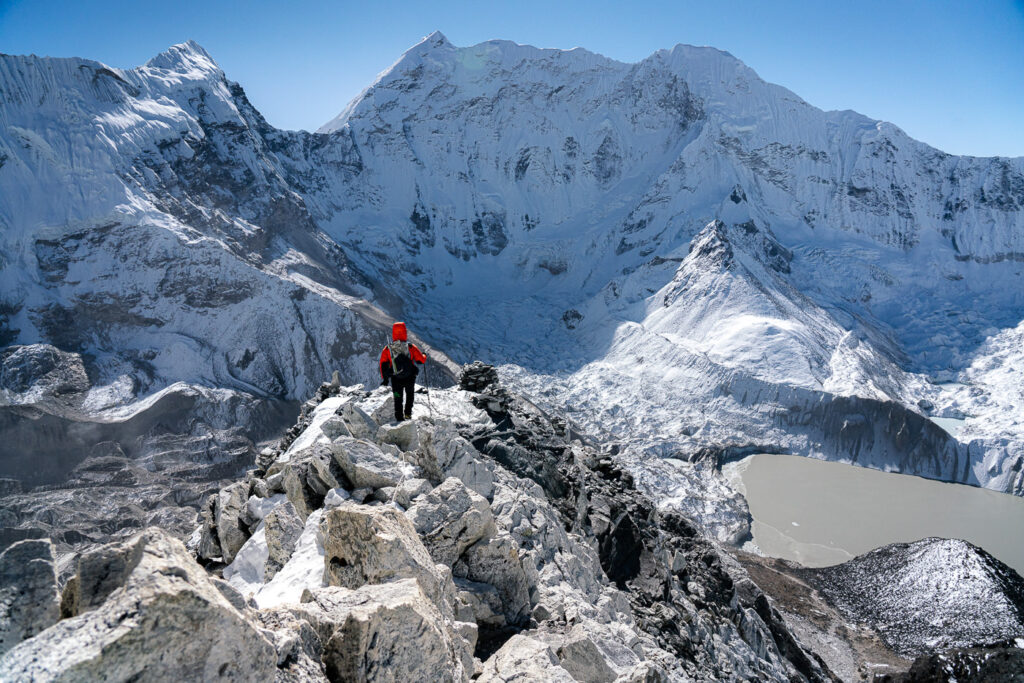
The first major checkpoint and achievement to tick-off are reaching crampon point. I’ll be honest, when we hit crampon point I thought we were almost there. It took us a few hours to reach this checkpoint where the snow and glaciers begin. The truth was, we still had quite a way to go.
It’s here that you will put your crampons and harness on in preparation for being roped up together to cross the glacier.
In some years the glaciers and crevasses are difficult to cross. Depending on their shape and movements over the winter, sometimes even ladders are needed to navigate the path across the crevasse field. The route is pre-set by the fixing team and there’s no need to navigate, simply follow the path that has been laid out and identified as the safest route that year.
For us, there were no ladders just some sizeable crevasses meters from the trail. Needless to say, we stuck closely behind our trusted Sherpa team as we made our way to the crevasse section while roped up together in case of an unexpected fall.
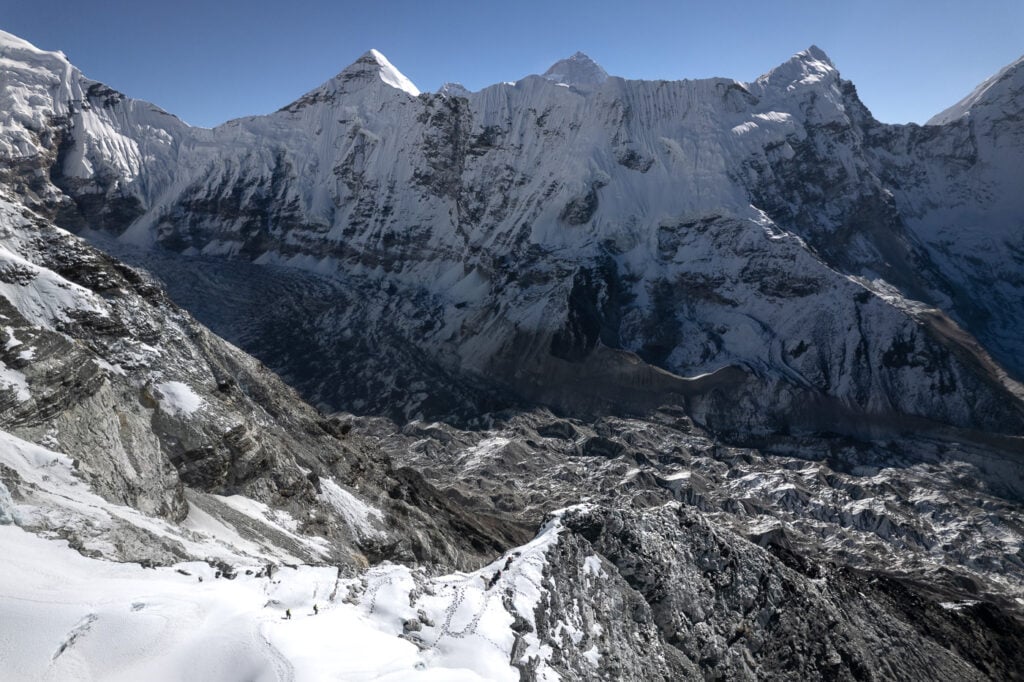
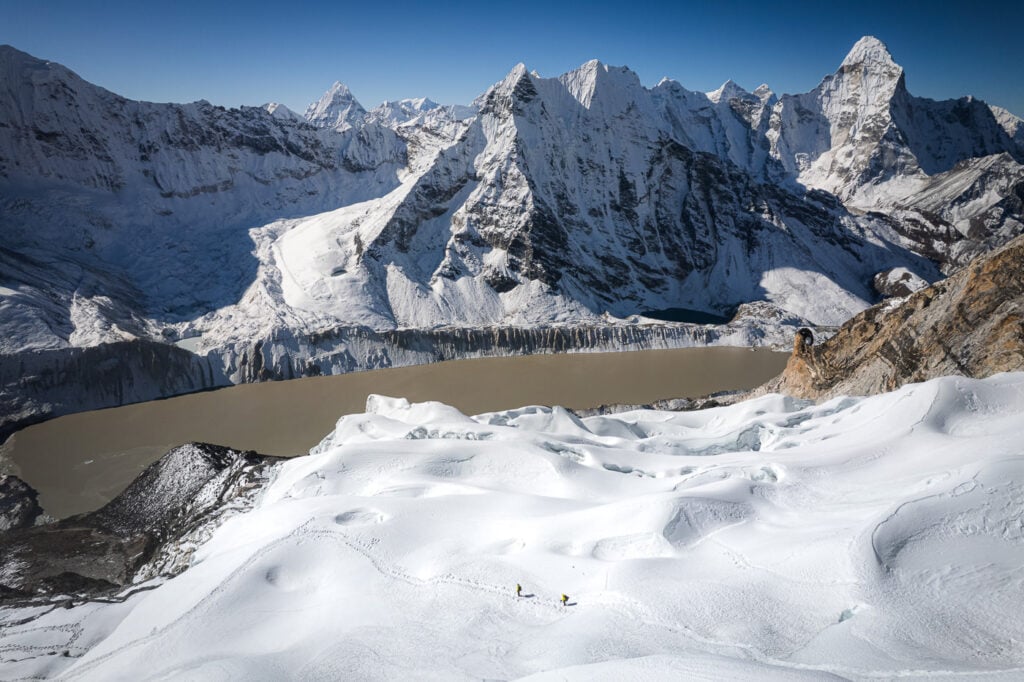

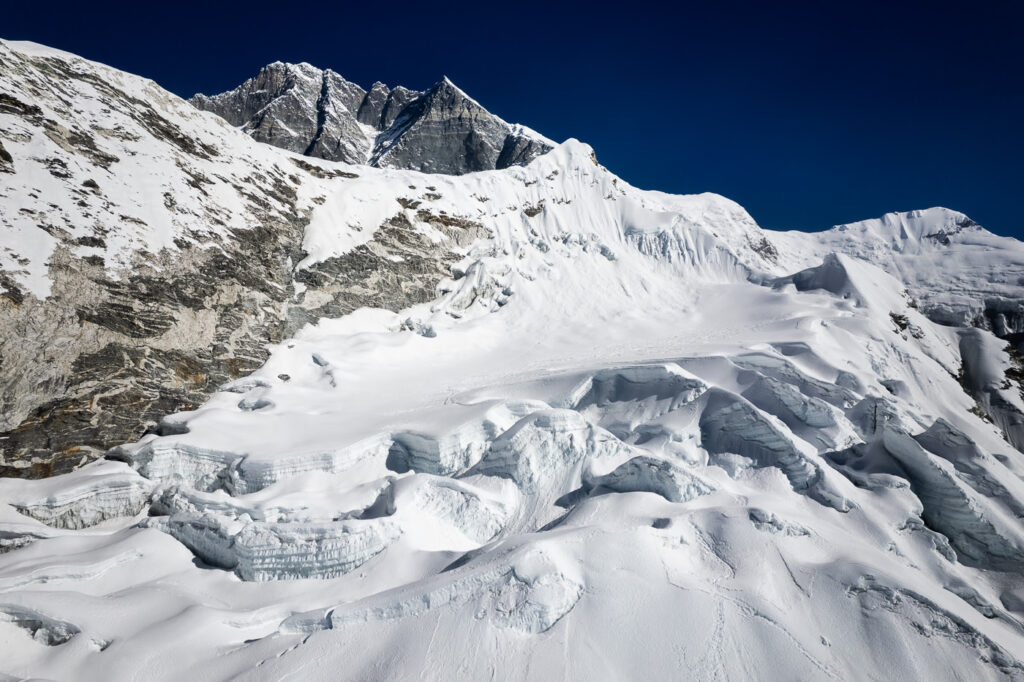
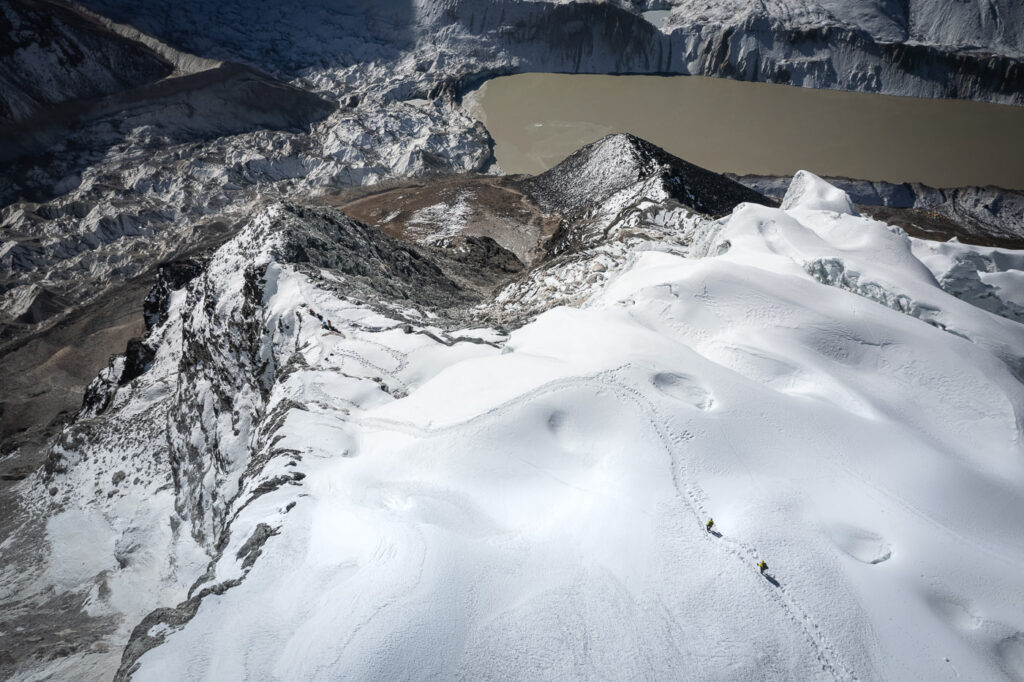
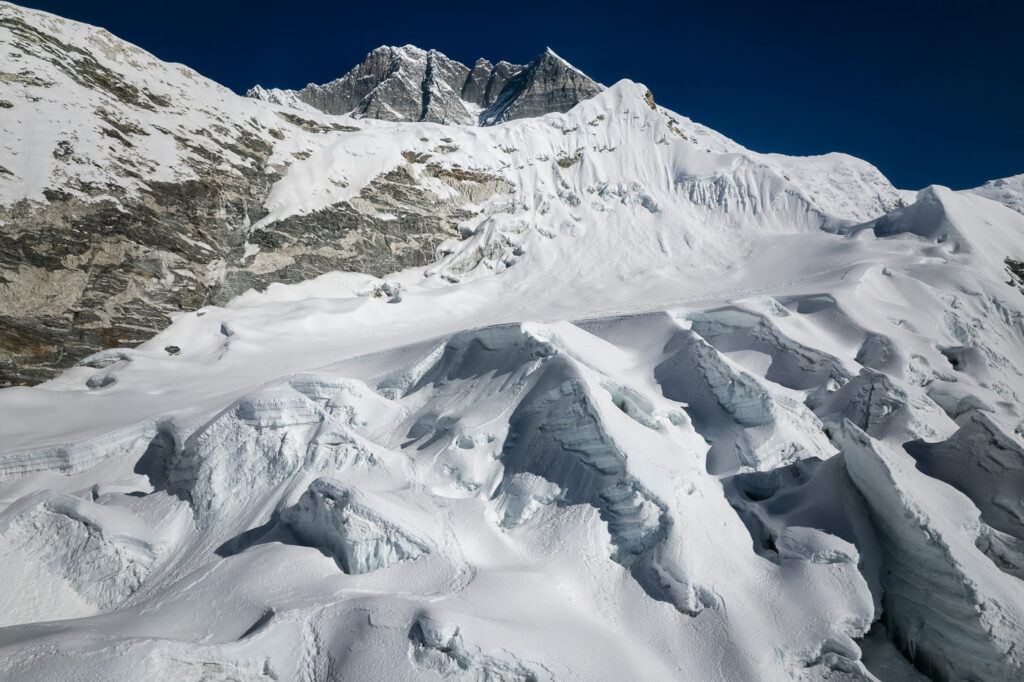
The route at this point has a few steep sections. You are now well above 5,500 meters so any small hill takes the wind out of most people and frequent resting becomes commonplace for most regular trekkers and beginner climbers.
After emerging from the crevassed area, we made it out onto the plateau that leads up to the wall of the summit ridge. The early morning glow of the sunrise began to reveal the surrounding peaks and we even had a spectacular view of Ama Dablam with a pastel sky as the backdrop. However, our attention was on the huge wall between us and the summit of Island Peak.
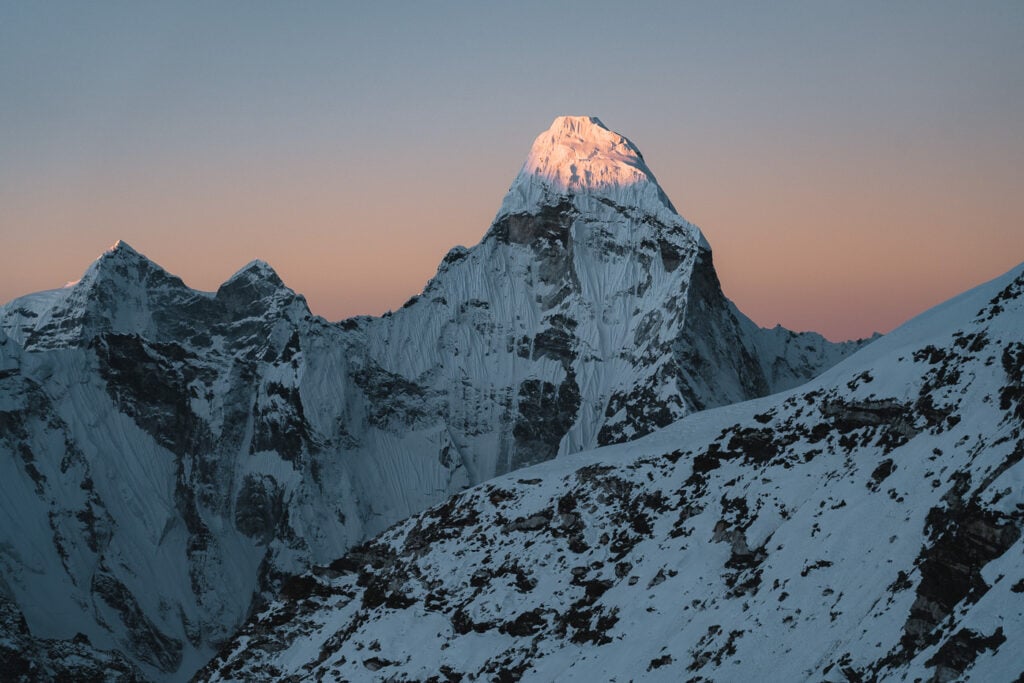
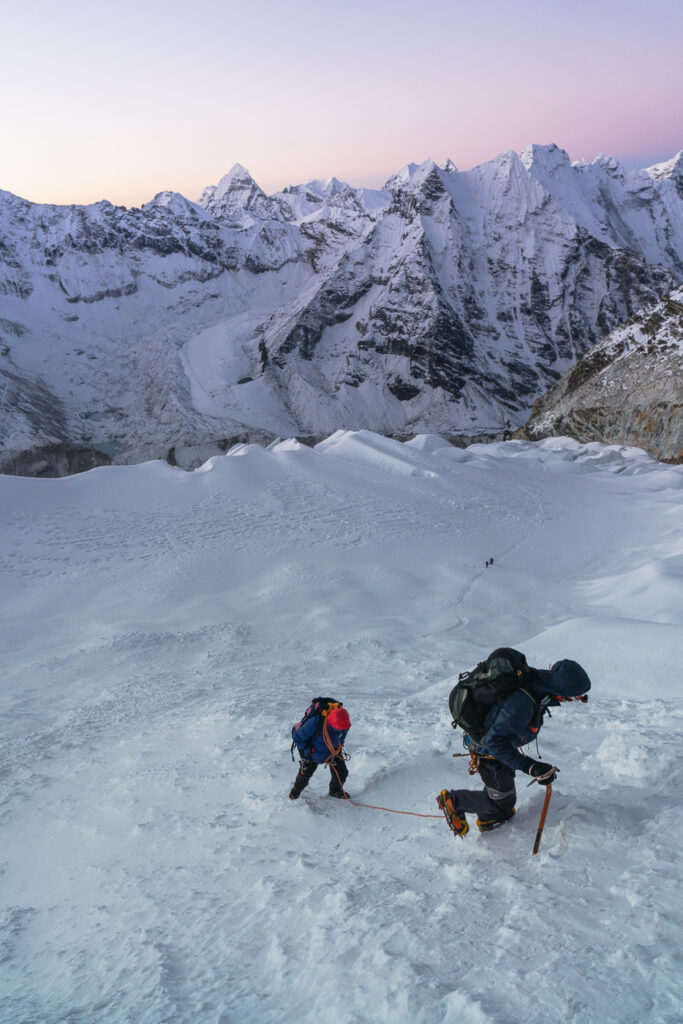
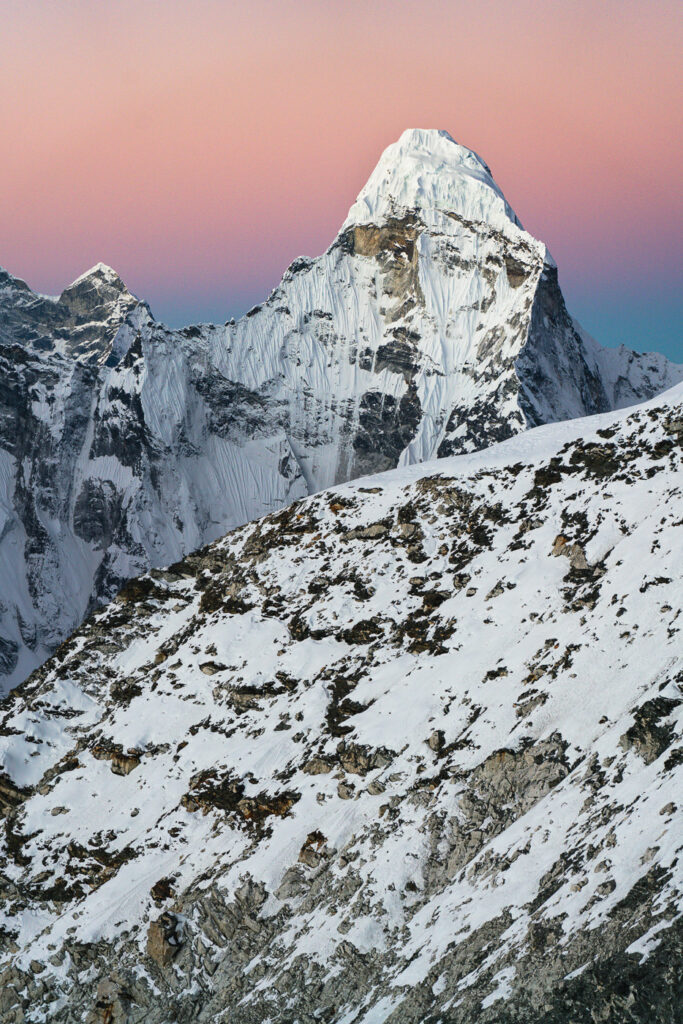

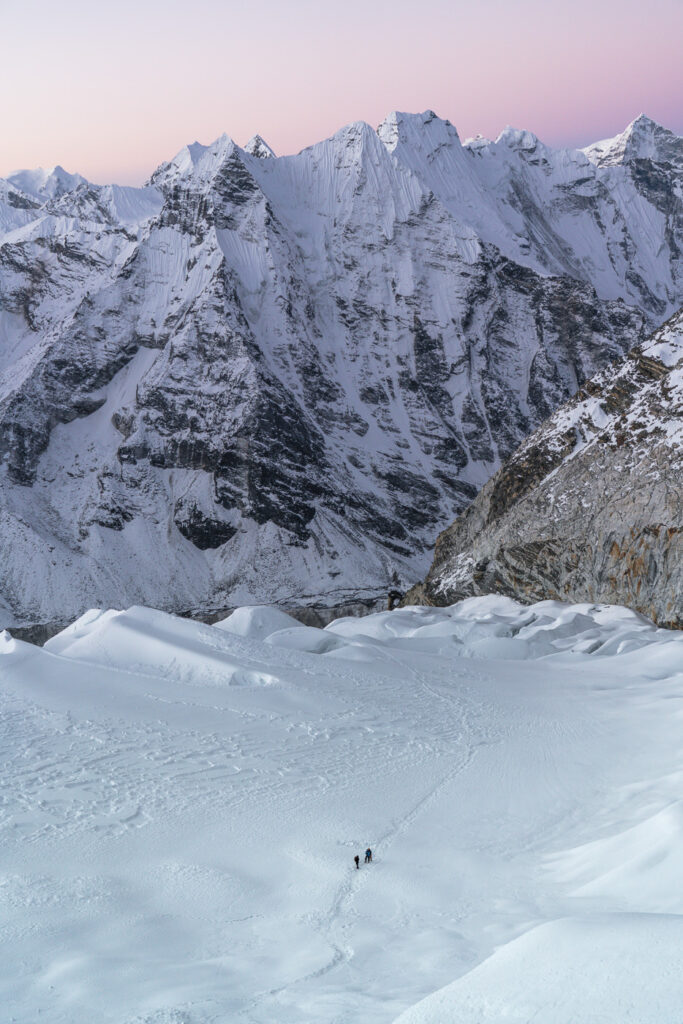
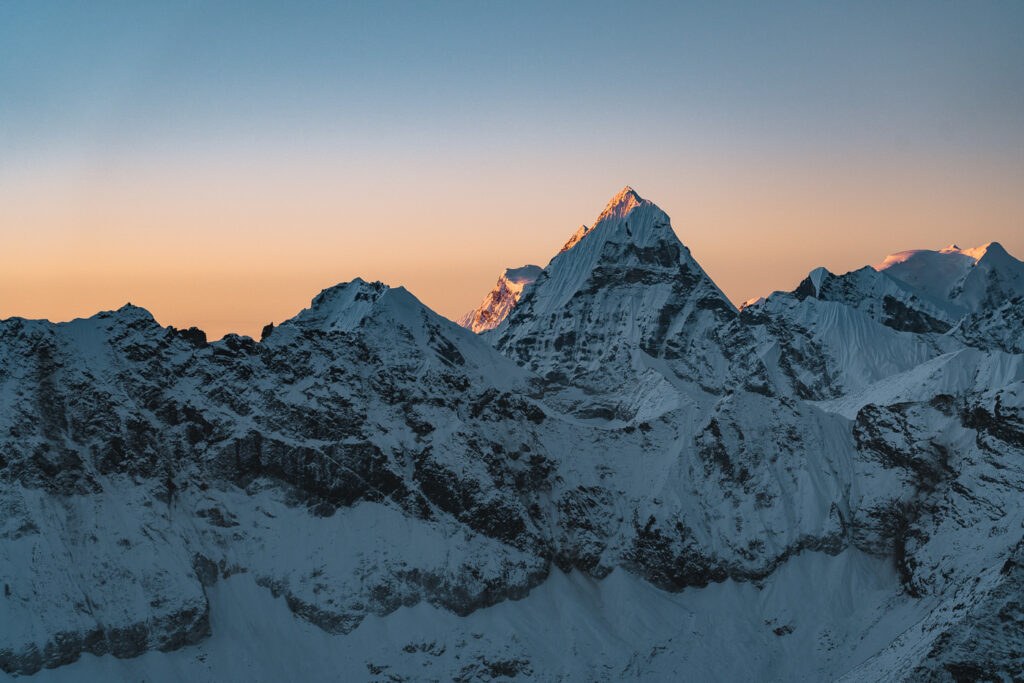
It was time to get out the jumar and switch from a being a trekker to a climber. Up until this stage, there is no tool or skill to use other than your feet and maybe being attached by a rope. Many trekkers wonder how hard it will be without skills but up until this wall, walking behind your Sherpa and handling the altitude and cold is all that is required of you.
While the wall is just 100m in height, you are at 6000m of elevation, tired and cold. This wall pushes most people and there were many climbers struggling on the morning of our climb. While not incredibly technical, you will use some snow steps and the use of your jumar to pull yourself up the wall.
There is no rush and once you reach this section you basically know you will summit, which is a great feeling. The jumar is not a hard skill to learn and even if you have no experience prior to the trip, with a small amount of coordination, you will get yourself up the wall.
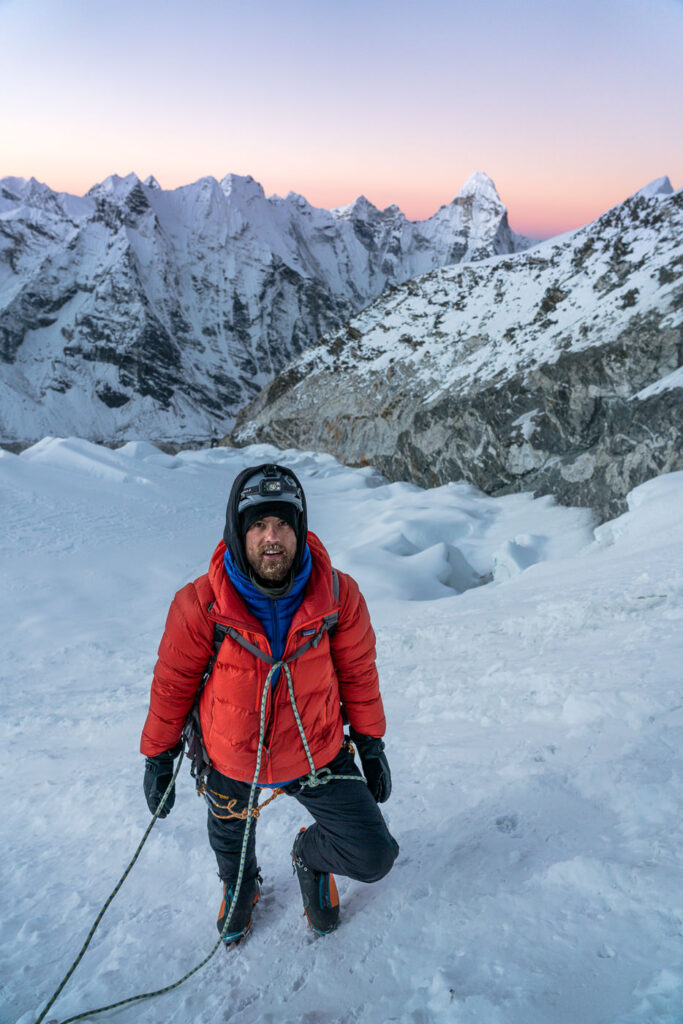
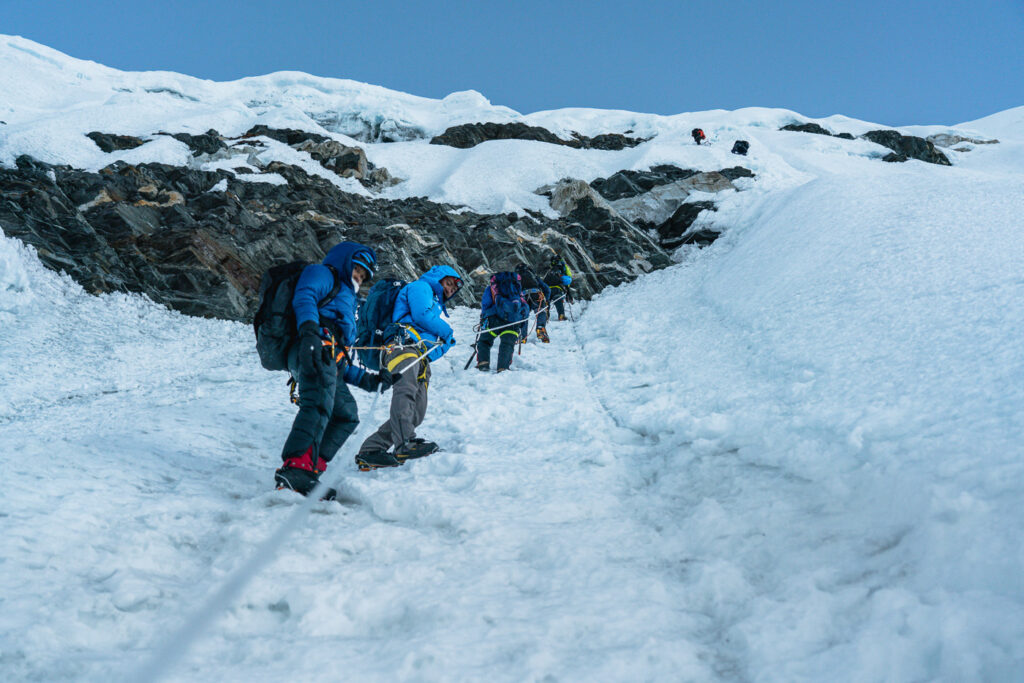
Once you defeat the wall, the views begin to reveal a spread of the Himalayas. There are peaks in all directions including Lhotse, Makalu, Ama Dablam, and more. The final push to the summit is a narrow ridge with heavy exposure.
Here you are clipped in or even double clipped (as I like to be) so while the drop-off is big, you should feel secure. The path is about a foot wide, enough to allow you to walk up the last stretch of incline to reach the summit.


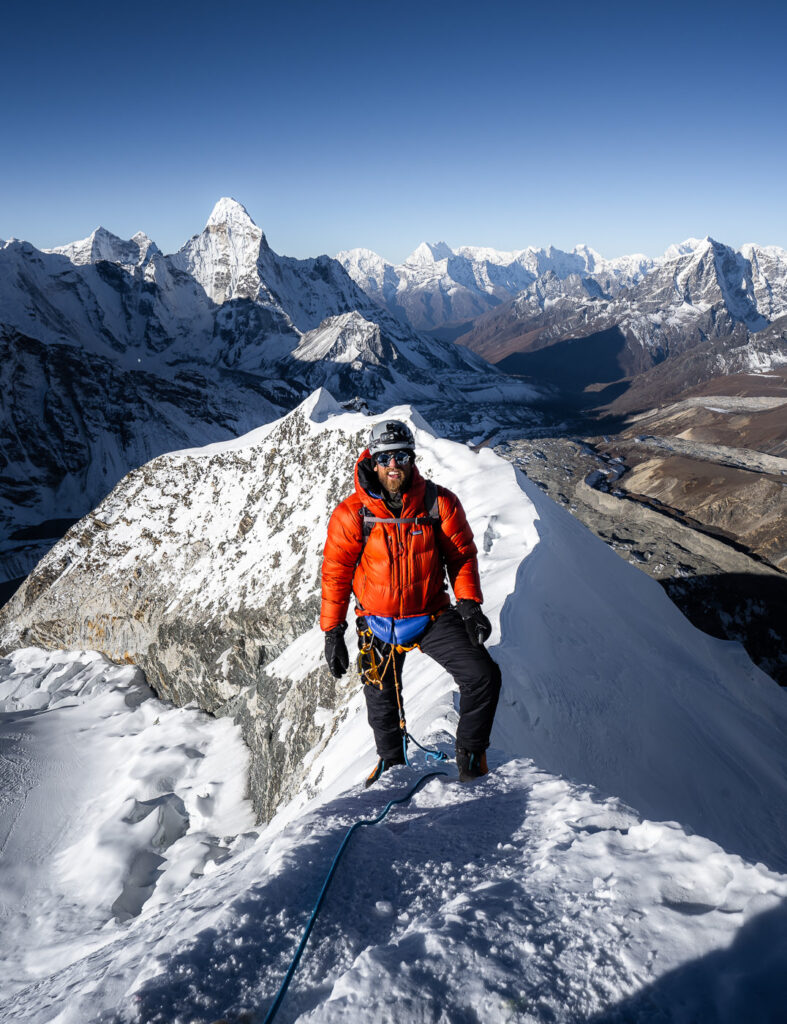
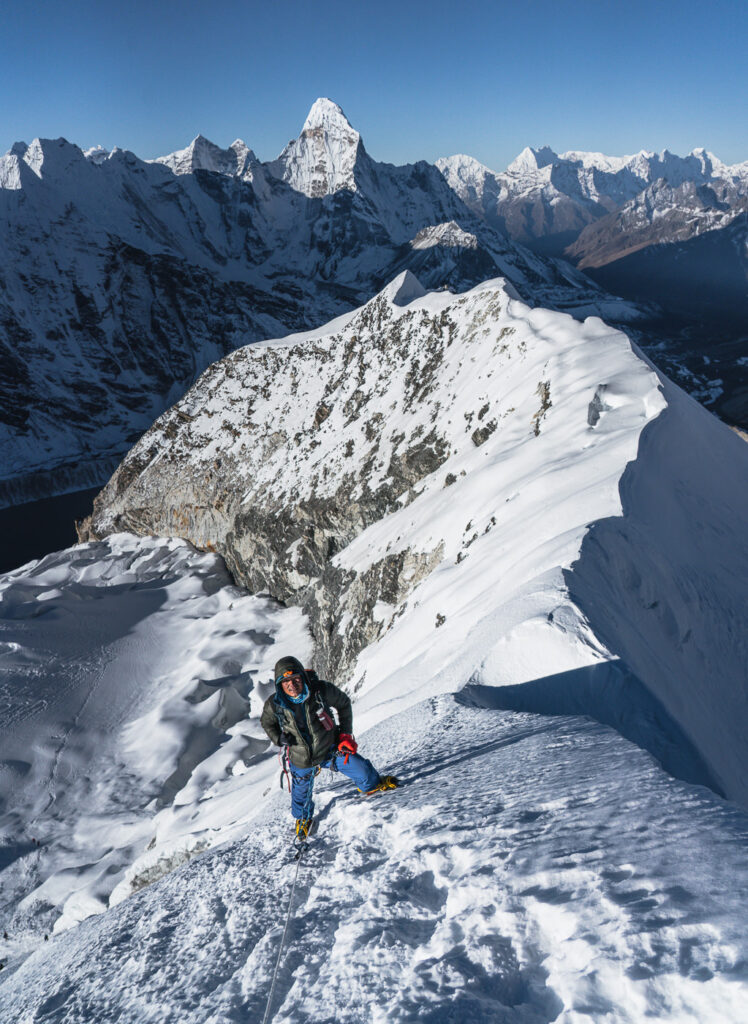
We made it! About half an hour after sunrise, our small team stood atop the summit of Island Peak. It’s a very small area atop the peak where we all clipped into a central anchor while enjoying the views. It was a very windy morning so after a few photos and a visual tour of the Himalayas, we began the 2-3 hour descent back to Island Peak Base Camp.
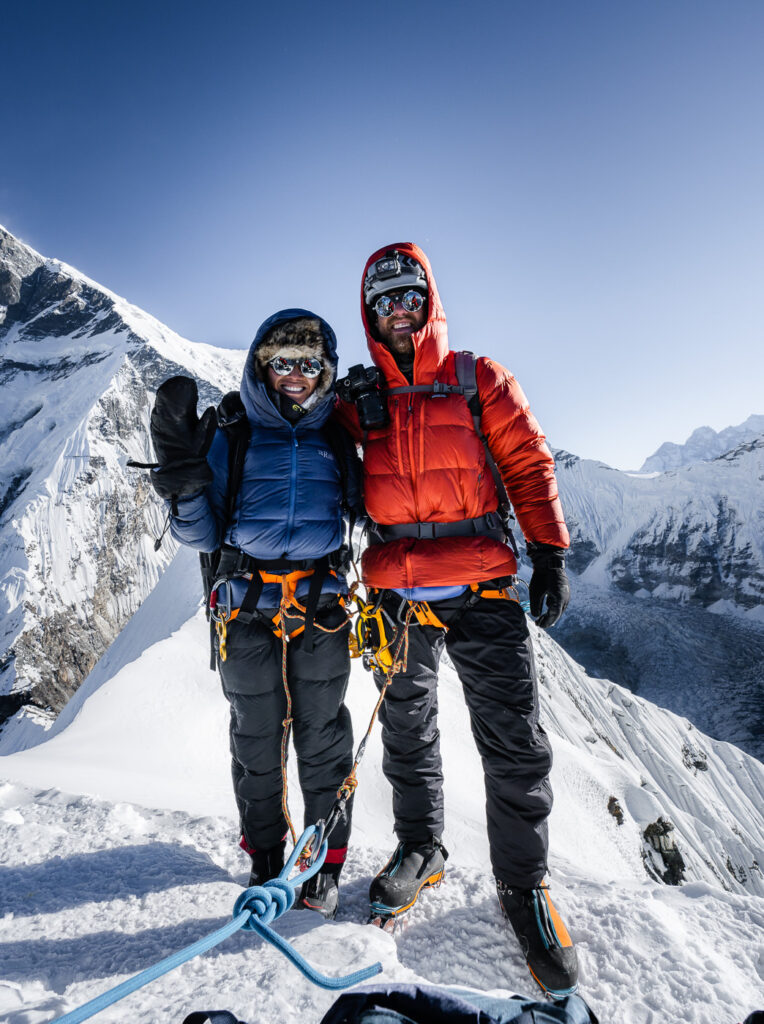
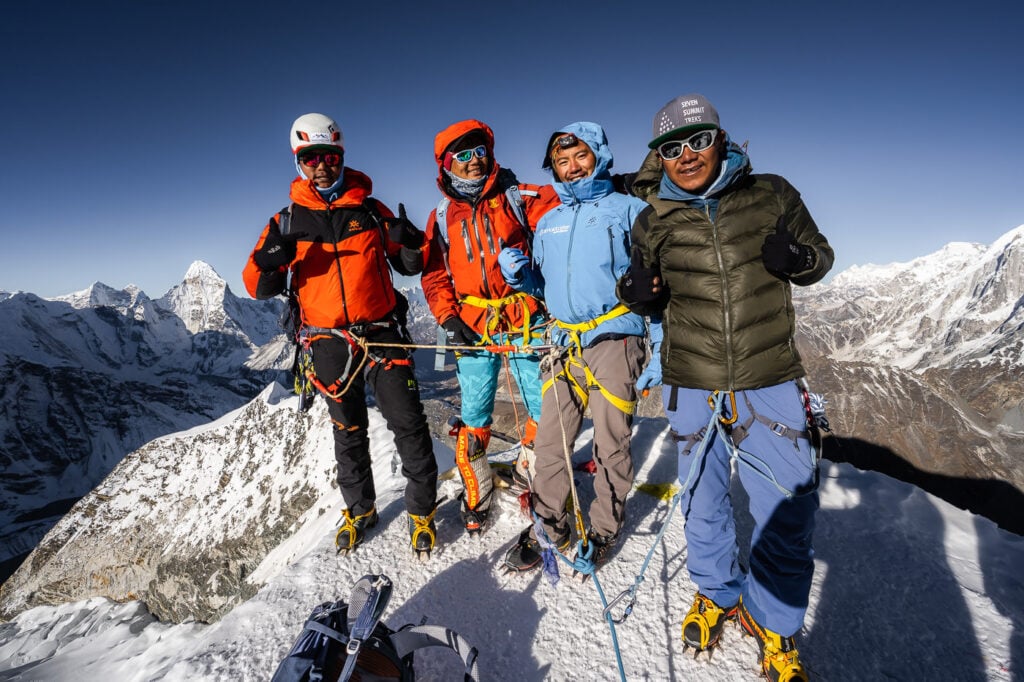
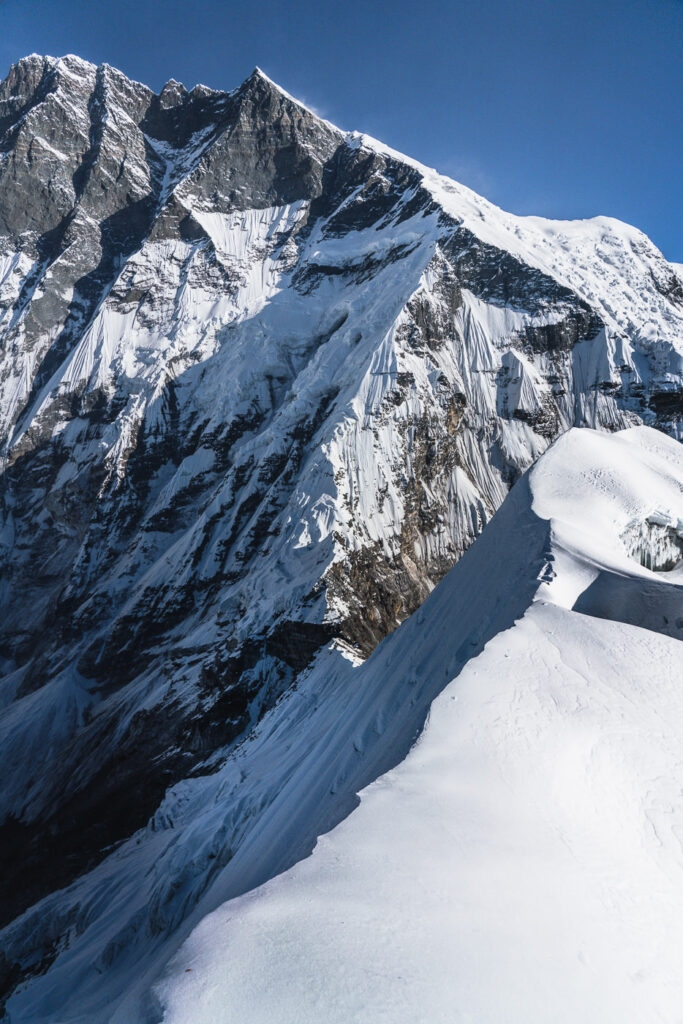
I hope you enjoyed this guide and review of climbing Island Peak in the Himalayas of Nepal. Happy climbing and stay safe out there.
HAVE YOU READ MY OTHER NEPAL BLOGS?
I’ve been lucky enough to have many awesome adventures in Nepal, which you can check out below where I’ve listed some of my favorite blog poss from Nepal.
- The Most Iconic route: Everest Base Camp Trek
- The Most Scenic Route: Annapurna Circuit Trek
- My Favorite Trek in Nepal: Manaslu Circuit Trek
- An Easy Nepal Trek: Langtang Valley Trek
- A great beginner peak: Island Peak Climb (6,165m)
- My Favorite Climb in Nepal: Climbing Ama Dablam (6,812m)
- My first 8000er: Climbing Manaslu (8,163m)
- My toughest climb in Nepal: Climbing Makalu (8,463m)
- Where to stay: 16 Best Places to Stay in Kathmandu


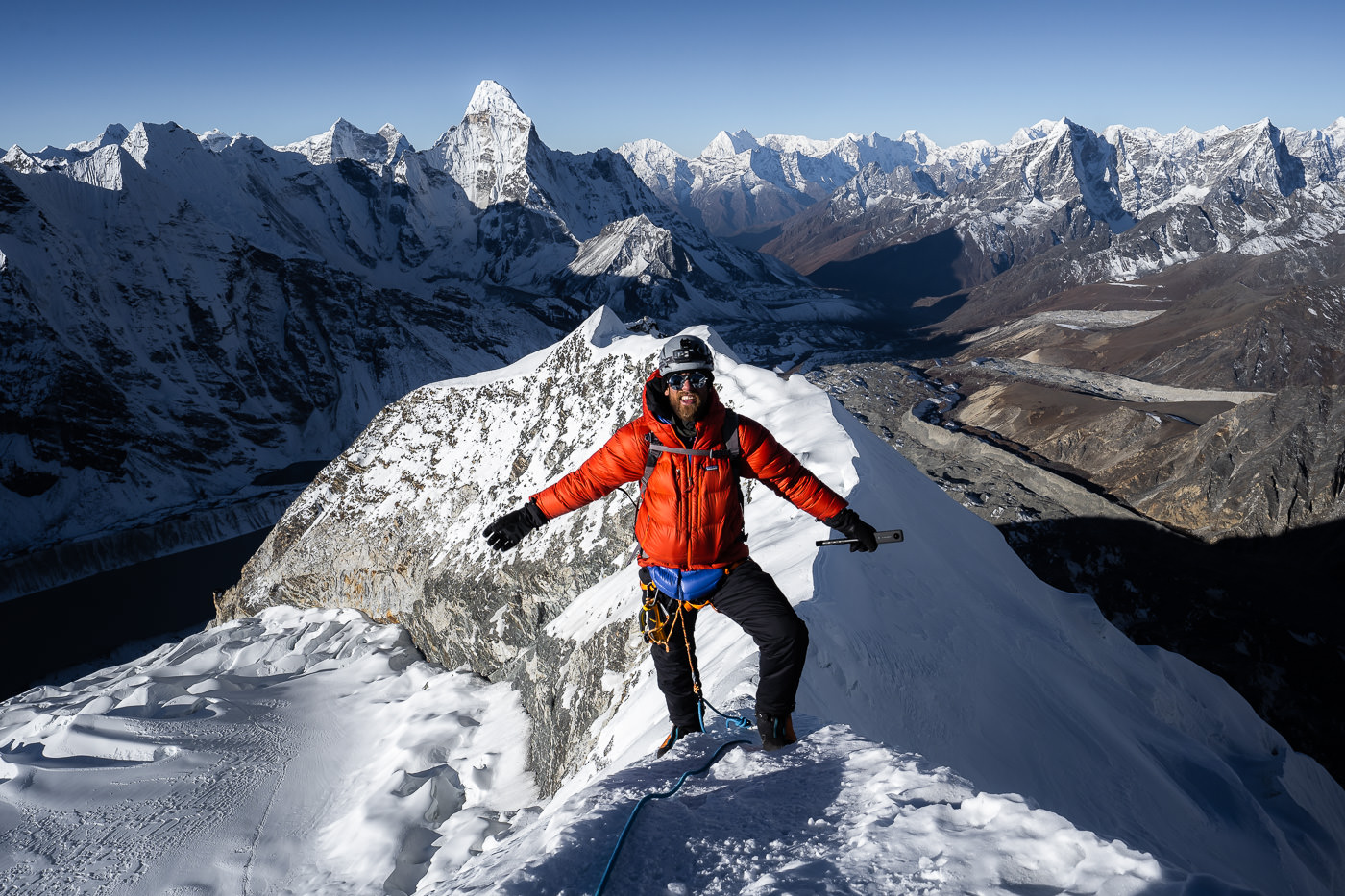
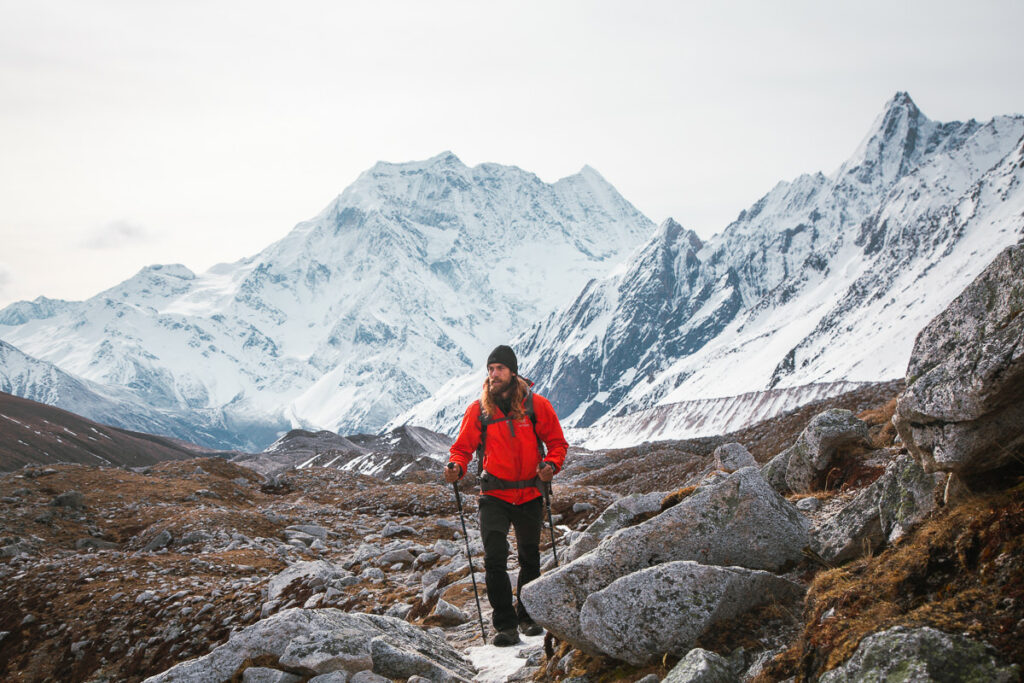
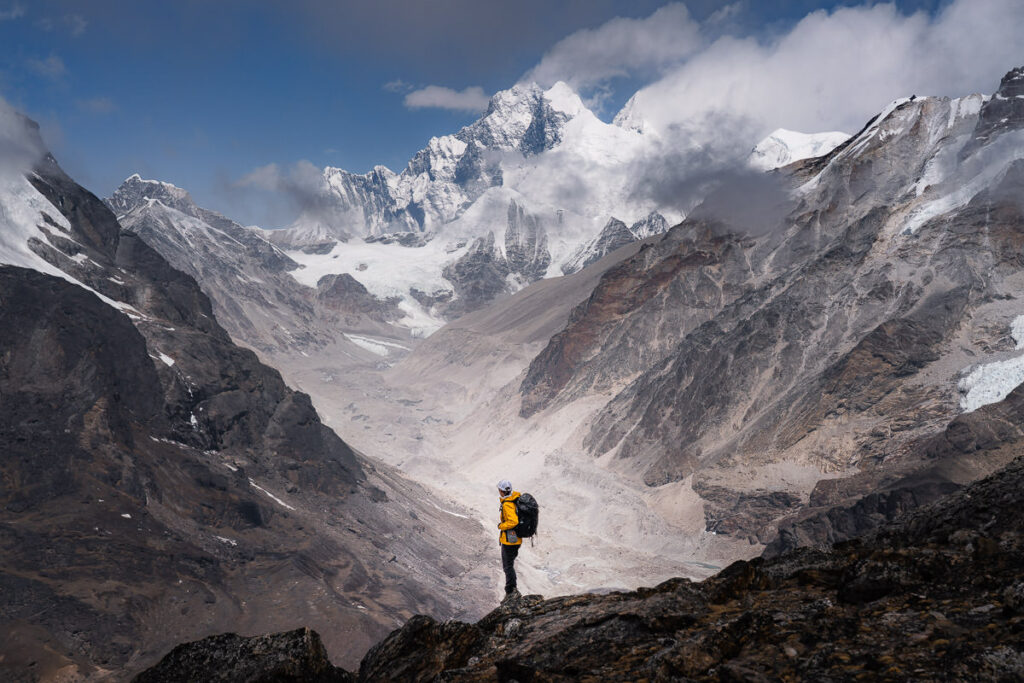
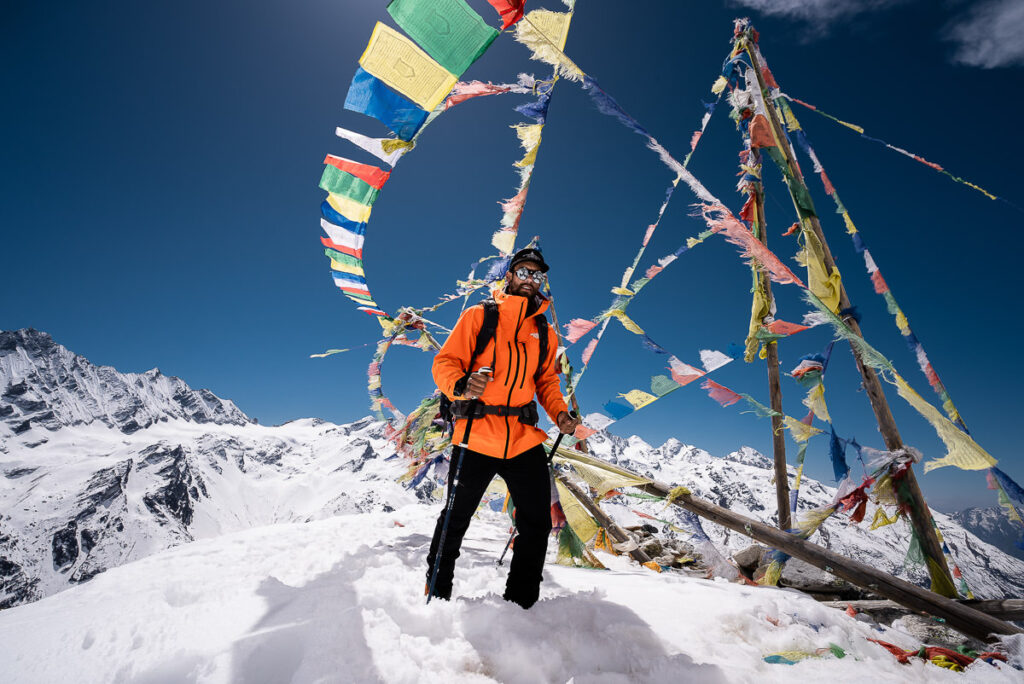
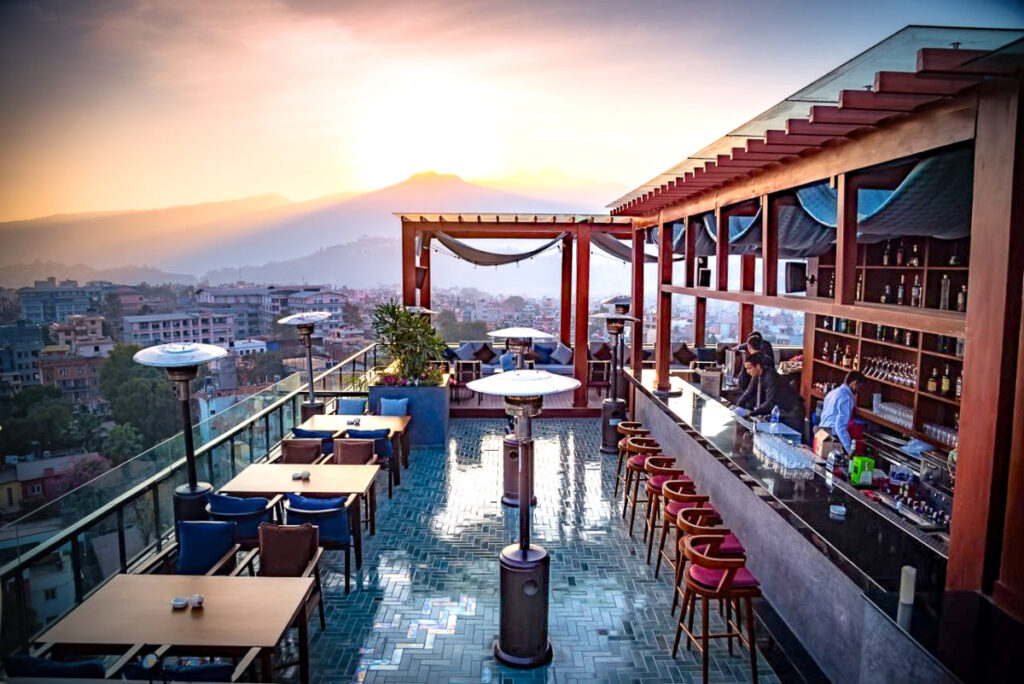
Sarba
Wednesday 30th of August 2023
Beautifully crafted article, thank you. https://www.nepalnomad.com/island-peak-climbing
Amara
Tuesday 15th of November 2022
Thanks for the detailed info. Just climbed Kilimanjaro and planning island peak for November 2023. Can I ask, how many layers did you have on for summit? Looks like a lot!
Pema
Friday 19th of November 2021
Summit Dream team! haha so cold 🙈 but worth it